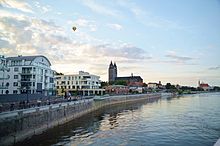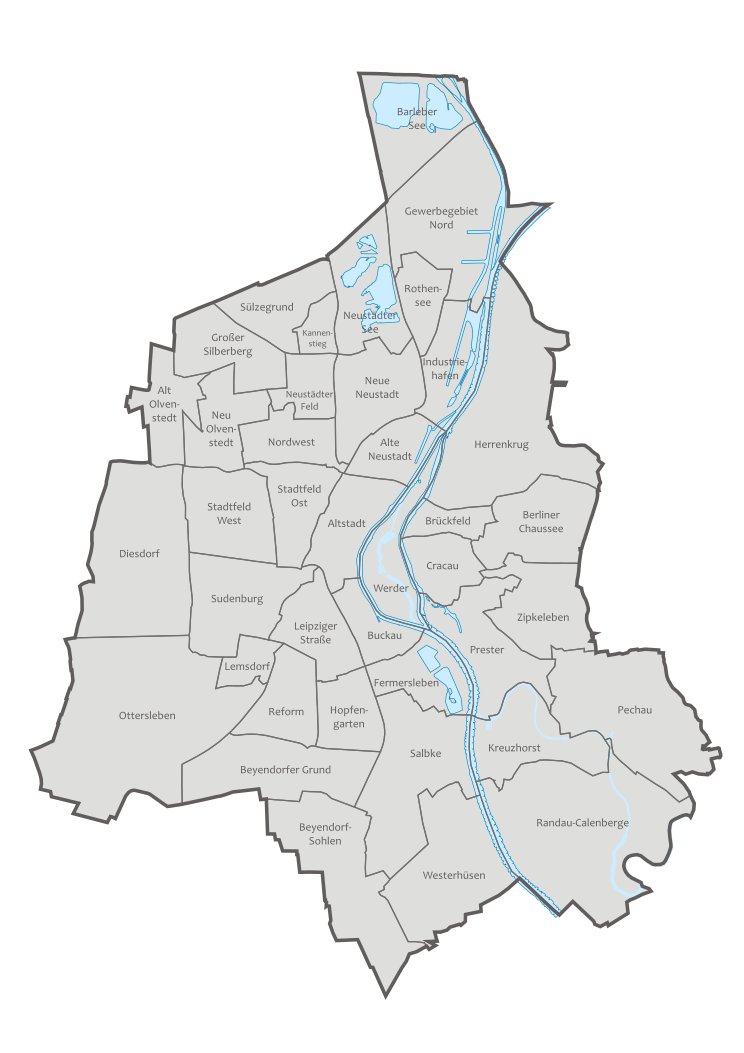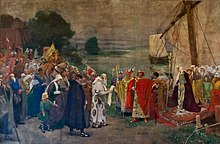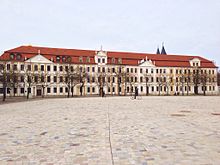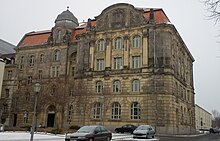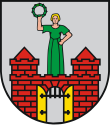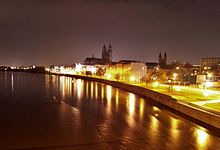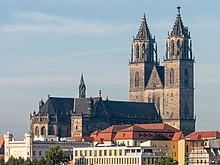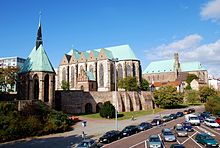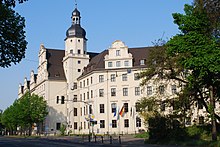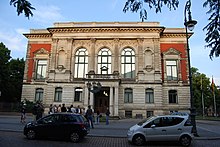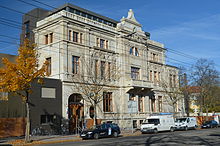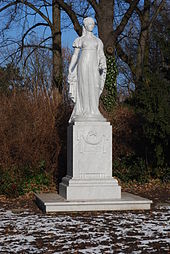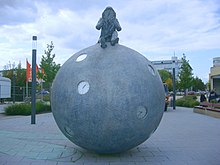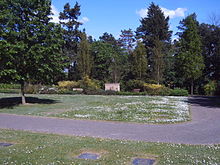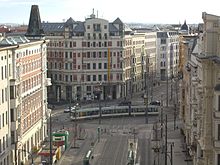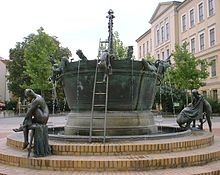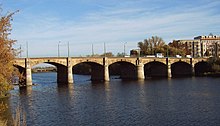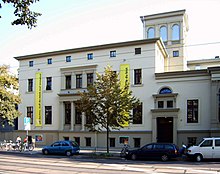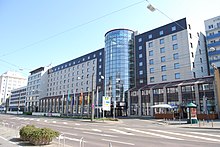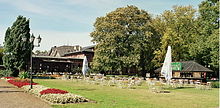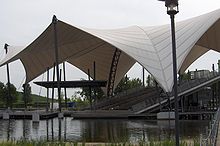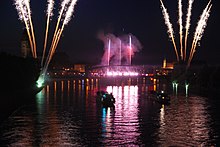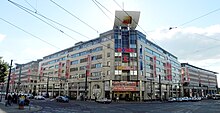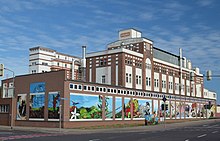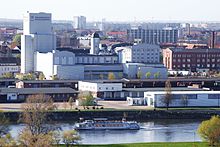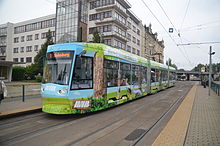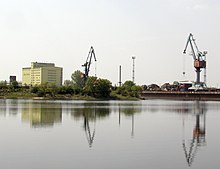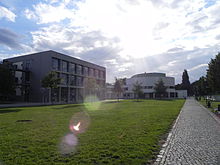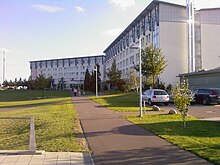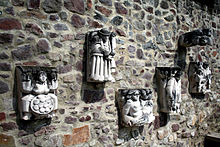Magdeburg
| coat of arms | Germany map | |
|---|---|---|

|
Coordinates: 52 ° 8 ' N , 11 ° 37' E |
|
| Basic data | ||
| State : | Saxony-Anhalt | |
| Height : | 55 m above sea level NHN | |
| Area : | 201 km 2 | |
| Residents: | 237,565 (Dec. 31, 2019) | |
| Population density : | 1182 inhabitants per km 2 | |
| Postcodes : | 39104-39130 | |
| Primaries : | 0391, 03928 | |
| License plate : | MD | |
| Community key : | 15 0 03 000 | |
| LOCODE : | DE MAG | |
| NUTS : | DEE03 | |
| City structure: | 40 districts | |
City administration address : |
Alter Markt 6 39104 Magdeburg |
|
| Website : | ||
| Lord Mayor : | Lutz Trümper ( SPD ) | |
| Location of the city of Magdeburg in Saxony-Anhalt | ||

Magdeburg ( [ ˈmakdəˌbʊʁk ] , Low German Meideborg ) is the capital of the state of Saxony-Anhalt . The city lies on the Elbe and is one of the three regional centers in the country. With 237,565 inhabitants (State Statistical Office as of December 31, 2019) Magdeburg is the second largest city in Saxony-Anhalt after Halle (Saale) and the fifth largest city in the new federal states . Magdeburg ranked 32nd on the list of major cities in Germany in 2019 .
The city was first mentioned in a document in 805. In 968 Otto I , the first emperor of the Holy Roman Empire (and together with Otto von Guericke namesake of today's "Ottostadt Magdeburg") founded the Archdiocese of Magdeburg . In the Middle Ages , the Hanseatic city gained great importance through free trade and Magdeburg city law . In the late Middle Ages it was one of the largest German cities and the center of the Reformation and the resistance against recatholization in the Schmalkaldic League . After the almost complete devastation in the Thirty Years' War (" Magdeburg Wedding "), Magdeburg was expanded to become the strongest fortress in the Kingdom of Prussia .
In 1882 Magdeburg became a city with over 100,000 inhabitants . During the Second World War , the city was hit hard again: After the air raid on January 16, 1945 , 90% of the densely populated old town , 15 churches and large parts of the Wilhelminian-style district were badly destroyed. During the GDR era, several buildings damaged or destroyed by the war were demolished, including the ruins of the Ulrichskirche in 1956 . From 1952 to 1990 Magdeburg was a GDR district town , since 1990 it has been the state capital of Saxony-Anhalt.
The city at the intersection of the Elbe, Elbe-Havel and Mittelland Canal has an important inland port and is an industrial and commercial center. Mechanical and plant engineering, health management, environmental technologies and recycling management , logistics and the manufacture of chemical products, iron and steel products, paper and textiles are of economic importance .
Magdeburg is both a Protestant and a Catholic bishopric. The symbol of the city is the Magdeburg Cathedral .
There are numerous important cultural institutions in the state capital, including the Magdeburg Theater and the Magdeburg Cultural History Museum . Magdeburg is also the location of the Otto von Guericke University and the Magdeburg-Stendal University of Applied Sciences .
geography
The independent city in the center of Saxony-Anhalt lies on the middle Elbe and on the eastern edge of the Magdeburg Börde landscape on old cultural soil and forms the center of the Magdeburg region (also called Elbe-Börde-Heide ). The center point of the location for determining the location of Magdeburg is the base of the northern tip of the cathedral, which is 56 m high. Magdeburg's highest point on the Hängelsberge, which belongs to the Börde range of hills, is 123.8 m above sea level. HN , the lowest point is 40.6 m above sea level. HN .
The city extends mainly on the western high bank of the river on a step in the terrain, which is formed by the cathedral rock ( sand and silt stones of the Rotliegend as an extension of the Flechtinger ridge ). Magdeburg is one of the few cities in the North German Plain that is founded on rock next to Grauwacke, a sandstone sedimentary rock from the Paleozoic Era , and to a small extent on pitchstone and ice-age flint deposits. The urban area is partly on an elongated island between the "Strom-Elbe" and the "Alte Elbe" as well as on the flat eastern bank of the river. The area of the urban area is about 201 km², the city's length limit including exclaves is 89.9 km long. 27.1 km of this border on the Jerichower Land , 18.3 km on the Salzlandkreis and 44.5 km on the Börde district .
As is typical for large eastern German cities, Magdeburg does not have a distinct suburban belt and is not located directly in a metropolitan area. Since the city acts as a major development engine for the surrounding region, it is classified as a regiopole . The closest major cities are Wolfsburg about 64 kilometers northwest, the twin city Braunschweig about 75 kilometers west, Halle (Saale) about 75 kilometers south and Potsdam about 105 kilometers east. Berlin is 130 kilometers to the east.
The Elbe crosses Magdeburg over a length of 21 km. Its zero level at the river bridge is 39.74 m above sea level. NN . The city also has several lakes, including the Salbker Lakes (together 51.7 ha) or the Barleber See I (103 ha) and II (71.9 ha).
According to a study from the first quarter of 2007, Magdeburg has the second largest share of public green spaces in the city after Hanover among the 50 largest German cities .
Neighboring communities
The following communities , named clockwise starting in the northeast, border the city of Magdeburg:
- in the district of Jerichower Land : Möser , Biederitz , Gommern
- in the Salzland district : Schönebeck and Bördeland
- in the district of Börde : Sülzetal , Wanzleben-Börde , Hohe Börde , Barleben and Wolmirstedt
Around 297,000 people live in the Magdeburg agglomeration .
Protected areas
In the Magdeburg area, 160 protected biotopes have been recorded so far, including moors, swamps, ravine, ravine and alluvial forests, clusters of trees, hedges and spring areas.
In Magdeburg, there is the “Kreuzhorst nature reserve” to protect nature and the landscape and to preserve and develop habitats . In the middle Elbe lowlands it includes one of the few near-natural alluvial forest complexes. There is mainly a common oak-ash forest there. So far 32 mammal species have been listed in the nature reserve, 16 of them on the Saxony-Anhalt Red List, three reptile and twelve amphibian species, six of which are endangered, eleven fish species, around 3000 butterfly species and 168 weevil species. It is worth mentioning the occurrence of stag beetles, billy goats, wolffish, a species threatened with extinction, Elbe beaver and the endangered polecat.
The Middle Elbe Biosphere Reserve is the habitat of many endangered animal species and, due to the large number of oxbow lakes, of high ecological value. It extends over parts of the flood plain and east of the flood dike.
There are also some protected parks in Magdeburg, such as the “Goethe facilities” or the “Schneider garden”, a biosphere reserve and protected waters.
climate
The average annual precipitation in Magdeburg is around 500 mm. Measured against the overall German average, this is considered low; the city is still in the rain shadow of the Harz Mountains . The average temperature in Magdeburg is 8.8 ° C, which is the national average. The driest month is February, the wettest month is June. The warmest month is July, according to statistics, the coolest month is January.
| Magdeburg | ||||||||||||||||||||||||||||||||||||||||||||||||
|---|---|---|---|---|---|---|---|---|---|---|---|---|---|---|---|---|---|---|---|---|---|---|---|---|---|---|---|---|---|---|---|---|---|---|---|---|---|---|---|---|---|---|---|---|---|---|---|---|
| Climate diagram | ||||||||||||||||||||||||||||||||||||||||||||||||
| ||||||||||||||||||||||||||||||||||||||||||||||||
|
Average monthly temperatures and precipitation for Magdeburg
Source: DWD ; wetterkontor.de
|
|||||||||||||||||||||||||||||||||||||||||||||||||||||||||||||||||||||||||||||||||||||||||||||||||||||||||||||||||||||||||||||||||||||||||||||||||||||||||||||||||||||
City structure
The city of Magdeburg is divided into 40 districts . In all parts of the city there are further subdivisions that have become established over the course of history. These are mostly new developments or residential areas, the boundaries of which can be blurred.
|
history
Meaning and origin of the name
Older forms of the name Magdeburg are ad Magadoburg , or Magathaburg in the 10th century. The basic word castle is familiar to everyone. Jürgen Udolph (for the first time 1999) suspects an - unused - Germanic adjective magaþ ("big, mighty"), that means "mighty castle", in the defining word . Harald Bichlmeier (2010) questions this hypothesis.
In terms of folk etymology , the derivation of maid ("virgin") has been in effect since the Middle Ages and is also reflected in the city's coat of arms. This interpretation resulted in a reference to the saga complex about Parthenopolis (Greek "Jungfrauenburg").
Prehistory and early history
Earliest hand ax discoveries are from the early Saale Ice Age dated before about 150,000 years ago and point out before modern Homo sapiens to a colonization of human forms.
Evidence of sedentary human presence in the Magdeburg area has been found since the late Vistula Ice Age (around 15,000 BC). During the Neolithic line ceramics , around 5400 BC. BC the area was populated by tribes of the Danubian culture. The fertile loess soil , the proximity of forest and water offered good conditions and the western bank of the Elbe offered protection from floods.
middle Ages

Magdeburg was first mentioned in 805 in the Diedenhof chapter of Charlemagne as Magadoburg and was imperial palace under Emperor Otto I the Great . However, the Magdeburg Elbfurt was also used to trade with the Slavs living east of the Elbe . The Saxon pennies , which were most likely introduced in Magdeburg with or soon after Otto I took office , were mainly struck for the Slavic trade.
In 929 Heinrich I arranged the marriage of his son Otto I to Edith ( Editha , Eadgyth), the daughter of Edward the Elder of Wessex . At the wedding, Edith received Magdeburg as a morning gift . In 937 an imperial assembly was held with the participation of two archbishops , eight bishops and the highest secular dignitaries. At the same time, the Mauritius Monastery (Moritzkloster) was founded in honor of St. Mauritius .
Queen Editha died in 946 and was buried in the monastery church, which later became Magdeburg Cathedral . Otto then married Adelheid of Italy , who strongly influenced the architecture of Magdeburg. Around 950 the diocese of Brandenburg was founded, which bordered the Magdeburg areas east of the Elbe. In 962 Otto the Great and his second wife Adelheid were crowned with the imperial crown of the Holy Roman Empire . As a result of the Synod of Ravenna in 967, Magdeburg was elevated to an archbishopric the following year . The first archbishop, Adalbert von Magdeburg , was later canonized as an apostle of the Slavs . The dioceses of Brandenburg, Havelberg , Meißen (until 1399), Merseburg , Posen (until about 1000), Zeitz-Naumburg and Lebus (only from 1420) belonged to the church province . In 973 Emperor Otto the Great died. He was buried next to his first wife Editha. In 995 Otto III. Silesia with a patent to the diocese of Meißen and subordinated it to the archbishopric Magdeburg .
In 1035 Magdeburg was declared a trade fair city . A patent gave the city the right to hold trade shows and conventions. Visitors from many countries traded in Magdeburg. A Magdeburg silver coin from the 11th century was found in the coin find of Sandur in the Faroe Islands . In 1126, Norbert von Xanten , who was later canonized, became Archbishop of Magdeburg. The “ Magdeburg Law ” developed in Magdeburg was considered practical, modern and exemplary and was therefore adopted in many areas of Central and Eastern Europe. Archbishop Wichmann passed the so-called "privilege" under Magdeburg law for the city of Magdeburg in 1188. In the 13th century, the city broke away from the city lord, the Archbishop of Magdeburg, but could never achieve complete freedom. In 1294, however, the citizens of Magdeburg bought the offices of mayor and burgrave from the archbishop and were able to occupy these offices themselves. This started a kind of local self-government in Magdeburg.
Magdeburg was an important trading center and hub in the Middle Ages. A large number of important long-distance connections originated from the city. For example, Heerstraße Magdeburg-Brandenburg was the most important connection to the east. The Lüneburg Heerstrasse connected Magdeburg with the cities in the north. Magdeburg's membership in the Hanseatic League cannot be fixed for exactly one year. It grew into the community of merchants and towns from the beginning. It is estimated that Magdeburg became a member of the Hanseatic League at the end of the 13th century (verifiable since 1295). It joined the Saxon city federations from 1351, 1404 and 1416 and developed next to Braunschweig into a suburb of the Saxon city federation . Due to the Magdeburg stacking law , the grain trade was monopolized on the middle Elbe. Because of its central position in the grain trade, Magdeburg was known as the “bread house of the Hanseatic League”. Magdeburg had long-distance relationships as far as northern France, Flanders, England, Poland, Russia, Sweden and Norway. In 1666 she resigned from the Union of Hanseatic Cities, and only in 2003 did she become a member of the New Hanseatic League again .
Around 1430 there were military conflicts between the city and the archbishop, which among other things tried to end the Council of Basel . In 1512 the archbishopric was assigned to the Lower Saxony Imperial Circle . In 1503 the archbishop moved his residence to Halle . The introduction of the Reformation in 1524 deepened the contrasts between the city and the archbishopric.
Early modern age
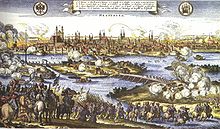
July 17, 1524 is considered the day the Reformation was introduced in all Magdeburg churches, after Martin Luther preached several times in Magdeburg in June 1524. Only the cathedral remained Catholic, but was closed for 20 years after the death of Archbishop Albrecht von Brandenburg in 1545. Because Magdeburg refused to recognize the Augsburg Interim in 1548 , Georg zu Mecklenburg moved against Magdeburg with the support of Emperor Karl V. After the heavy defeat of Magdeburg troops near Hillersleben, Georg zu Mecklenburg besieged the city from September 22nd, 1550 to November 5th, 1551. A peace treaty ended the siege. Magdeburg was subsequently called "Our Lord's Chancellery" by Protestants.
During the Thirty Years' War Magdeburg was conquered by imperial troops under General Tilly of the Catholic League on May 20, 1631 (May 10 according to the Julian calendar ) and then went up in flames (" Magdeburg Wedding "). This process gained notoriety under the term Magdeburgize . Except for a few thousand people, the inhabitants were killed by the advancing troops and the fire. The city was largely destroyed and almost completely depopulated. With 20,000 (according to other sources up to 30,000) dead, this is considered the largest single massacre of the Thirty Years' War. 205 pamphlets and 41 illustrated leaflets reported on the events in and around Magdeburg. In 1635, in the Peace of Prague , the city and the archbishopric were given to the Saxon Prince August , who had been elected administrator in 1628 . In the Peace of Westphalia in 1648, the Archbishopric of Magdeburg was awarded to the Electorate of Brandenburg as an entitlement, but this was only to be redeemed after the death of the Electorate of Saxony administrator. At that time (1646 to 1678) Otto von Guericke was mayor of Magdeburg. He was also a physicist, invented the piston air pump and, from 1654, carried out the famous vacuum experiments with the Magdeburg hemispheres .
In 1680, after August's death, the archbishopric, now secularized as the Duchy of Magdeburg, and with it the city, came under Brandenburg rule. The city was in what was then Holzkreis , but as a so-called immediate city, it was directly under the government of the duchy and became its capital in 1714. From June 1681 to January 1682 the plague raged in Magdeburg and claimed at least 2,649 lives.
As a result of the Edict of Potsdam of the Brandenburg Elector Friedrich Wilhelm of October 29, 1685, in which religious refugees from France were invited to settle in the country, the French Colony in Magdeburg was created . Also a request for admission of the Mannheim expellees was on April 13, 1689 by Elector Friedrich III. approved. This resulted in the establishment of the Palatinate Colony . Both colonies formed independent political communities within the city, which were not spatially separated from the old town. They had their own town halls, mayors, courts and their own civil guards . Its members were under the protection of the elector and later the king. The colonies existed until 1808. In 1666, the Elector of Brandenburg had Otto Christoph von Sparr besieged the city with an army of 15,000 men, which at the time probably had fewer than 1,000 inhabitants, in order to enforce compliance with its obligations under the Peace of Westphalia. Then he had the fortifications destroyed in the Thirty Years War rebuilt. In the 18th century the Magdeburg fortress was further expanded. Under Frederick II , the fortress took up 200 hectares ; the city area, on the other hand, only reached 120 hectares. Magdeburg is mentioned several times as the strongest fortress in Prussia . She surrendered to French troops in the Fourth Coalition War on November 8, 1806 without a formal siege.
19th century
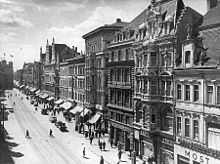
In 1807 the city was temporarily annexed to the Kingdom of Westphalia and became the seat of the Elbe department . After the war, which was lost for Napoleon , Magdeburg came back to Prussia in 1814 and in 1816 became the capital of the province of Saxony and the seat of the administrative district of Magdeburg and the urban district of Magdeburg, to which the actual city of Magdeburg, the cities of Neustadt-Magdeburg and Sudenburg as well as several surrounding villages belonged.
The Magdeburg Stock Exchange was founded in 1824 . In 1828 the villages Cracau and Prester moved from the Magdeburg district to the Jerichow I district and the village of Buckau to the Wanzleben district . Buckau , elevated to a town in 1859, returned to the Magdeburg district from the Wanzleben district in 1862. On July 1, 1867, the city of Sudenburg was incorporated into the city of Magdeburg.
Since 1866 the headquarters of the IV. Army Corps , a large unit of the army of the North German Confederation and from 1871 of the German Empire, was in Magdeburg . With the beginning of the First World War , the city was the VI. Army inspection subordinated. One of the commanding generals was the future President Paul von Hindenburg .
On April 1, 1886 Neustadt-Magdeburg was incorporated into the city of Magdeburg. On April 1, 1887, the town of Buckau was incorporated with its mechanical engineering and valve factories. The urban district and the city of Magdeburg have been congruent since then. The Polte-Werke in Sudenburg, the Buckau-based Grusonwerk , the Schäffer & Budenberg measuring devices and fittings factory , the fittings factory of C. Louis Strube and the mechanical engineering company R. Wolf established Magdeburg's tradition as a city of mechanical engineering.
Weimar Republic and National Socialism
In the 1920s, under Mayor Hermann Beims , Magdeburg became the center of new building . Bruno Taut was a city councilor from 1921 to 1924 . Modern residential areas emerged in the suburbs, such as the Beimsiedlung in the Stadtfeld West district and the Reform Garden City . Other important buildings were the exhibition center in Rotehornpark and the Magdeburg city hall . Both were built on the occasion of the 1927 German Theater Exhibition in 1927 .
In 1930, the twenty-year-old Jacques Decour was an exchange teacher for French at the Domgymnasium Magdeburg . His diary, published in Paris in 1932 under the title Philisterburg , soberly described everyday life in the Weimar Republic and common anti-Semitism.
During the time of National Socialism , political and ideological opponents as well as many people who were excluded from the "national community" for eugenic and racist reasons were persecuted . The largest group numerically were Jews . In 1939 an “alternative or reception camp” was set up by the Gestapo headquarters in Magdeburg, where those arrested after the November pogrom and later deported forced laborers , but also political prisoners , so-called mixed race and other groups, were interned and loaned from there to Magdeburg armaments factories.
During the Second World War , industrial production was maintained by employing foreign slave labor . The lignite gasoline company ( Brabag ), the largest fuel supplier to the Wehrmacht, set up six external concentration camps in 1944 . One of them, the " KZ Magda ", was in Magdeburg-Rothensee. The other five were in other places in Saxony (Lausitz) and what is now Saxony-Anhalt . Between June 1944 and February 1945, 2,172 Jewish prisoners worked there , around 65% of whom died.
The Magdeburg Holzweg gypsy camp was built especially for Sinti and Roma . The prisoners were taken to the Auschwitz concentration camp .
From 1943 to 1945 a subcamp of the Buchenwald concentration camp was located at the Polte-Werke in Magdeburg's Liebknechtstrasse . Over 3,000 inmates - mostly Jews from the Riga-Kaiserwald , Auschwitz , Stutthof and Ravensbrück as well as Russian and Polish prisoners - had to do heavy work here and lived in a barrack camp in Prester .
The first air raid on the city took place on August 22, 1940. From 1943 Magdeburg was attacked intensively by Allied bomber groups. The first targets were companies in the armaments industry , such as the Krupp Grusonwerk in Buckau , where tracked vehicles ( Panzer IV and Sturmgeschütz IV ) were built, the ammunition manufacturer Polte-Werke and in Rothensee the Brabag - hydrogenation plant for the production of synthetic gasoline for the Air Force . The air raid on Magdeburg on January 16, 1945 by the British Royal Air Force destroyed around 90% of the old town, including 15 churches. The Wilhelminian-era district also suffered considerable damage. The “Nordfront” district near the old town and the Breite Weg , one of the most beautiful baroque streets in Germany, were almost completely destroyed. At least around 2,000 people were killed in this attack and a further 190,000 were bombed out (homeless).
On April 11, 1945 troops of the 9th US Army took up positions on the western city limits. A handover was refused on April 12th by General Adolf Raegener . After several days of bombardment, the American units broke through the strong German defense lines and occupied the western part of the city on April 19, 1945. As agreed, they did not advance further in the direction of Berlin. On May 4, 1945, Hans-Georg von Friedeburg near Lüneburg signed the partial surrender for the troops in Northern Germany , Denmark , Holland and Norway on behalf of the last Reich President Karl Dönitz , who had left for Flensburg - Mürwik with the last Reich government . Thereupon the parts of the 9th Army and the 12th Army still on site withdrew from the area east of Magdeburg to the American-occupied area west of the Elbe. On May 5, the Red Army occupied the east Elbe part of Magdeburg. An American special unit captured silver supplies from the Reichsbank (worth eight million euros), which were brought to the USA . The silver had withstood aerial bombardment and artillery fire in a very secure underground depot built in 1927 in Toompea. On June 1, 1945, the last forces of the 117th US Infantry Division were replaced by British troops, who handed over Magdeburg-West to the Red Army on July 1.
Post-war and GDR times
After the war, the city center and the affected districts were cleared of rubble (see “ Rubble Women ”). Until 1953, the Magdeburg large-scale enterprises contributed as SAG enterprises to the fulfillment of the reparation obligations imposed on Germany . For lack of money as a result of these reparations, but also with the ideological goal of creating a new socialist city, only a few of the damaged buildings were rescued, or the buildings less affected by destruction were restored, including the Magdeburg Cathedral, the Monastery of Our Dear Women and that Town hall. Between 1951 and 1966, eight churches were blown up or demolished, although they were burned out but could be rebuilt: the Luther Church was demolished in 1951, the German Reformed Church in 1955. In April 1956, by order of Walter Ulbricht, the Ulrichskirche was in the middle of the former Old town blown up. In 1959 two secularized churches were demolished and three other churches blown up: Sankt Jakobi , Martinskirche and Heilig-Geist-Kirche (Sankt Spiritus: rebuilt from 1848 to 1950, was used). On October 20, 1960, the French Reformed Church was blown up and in 1964 the nave of Sankt Katharinen . Its towers were demolished in 1966. From 1965 to 1969 the old town hall was rebuilt true to the original. In the meantime, instead of the Baroque houses on the Breite Weg , the Wilhelminian style and Art Nouveau buildings, numerous buildings from the national tradition of the post-war period, based on Soviet architecture from the Stalin era ( socialist classicism ), characterize the city center. The large number of prefabricated buildings in the city center and in new development areas were largely replaced by modern buildings from the 1990s and the turn of the millennium after reunification.
In the GDR , Magdeburg remained the location of heavy machinery construction (for example SKET ) and in 1952 became the district town of the Magdeburg district , which was dissolved again in 1990. Within the district, Magdeburg was an independent city ("Stadtkreis").
1990 to the present
In June 1990, the People's Chamber decided to (re-) introduce Länder and reorganize the GDR into federal states. The districts of Halle and Magdeburg as well as the district of Jessen essentially formed the state of Saxony-Anhalt , as it had already existed from 1947 to 1952 within changed boundaries. At that time, the relatively undestroyed Halle was designated the state capital.
On Sunday, October 28, 1990, the constituent meeting of the new state parliament of Saxony-Anhalt took place in Dessau in the hall of the Johann-Philipp-Becker-Bundeswehr barracks . The 106 freely elected representatives of the re-established central German state had to vote on whether Magdeburg or Halle (Saale) should become the capital of Saxony-Anhalt. Halle was defeated by just eight votes: The result was 57 to 49 votes in Magdeburg's favor. Magdeburg became the state capital as well as the seat of parliament and a serious, month-long dispute ended.
As in some other German cities in the early 1990s, there were xenophobic riots in Magdeburg in 1994 with the so-called Magdeburg Ascension riots. Right-wing extremist youths were able to chase a group of black Africans through Magdeburg's inner city for hours, injuring six people.
Magdeburg became the seat of a Roman Catholic bishop again in 1994 . The diocese of Magdeburg has since been a suffragan of the Archdiocese of Paderborn . In 1999, the 25th Federal Garden Show (BUGA) was held in Herrenkrug on part of the approximately 100 hectare site that was formerly used by the military .
The neighboring barracks from Wilhelmine times has become the seat and location of most of the departments of the Magdeburg-Stendal University of Applied Sciences . In a national student survey in 2009, this campus was voted the second most beautiful campus in Germany. Other former barracks buildings located in the East Elbe district of Brückfeld now house various state ministries after they have been refurbished and redesigned in accordance with historical monuments.
Since reunification, many large and small construction projects have changed the cityscape significantly: the central axis of the city, the Breite Weg , was one of the longest shopping streets in Europe before the Second World War and has been closed again with many new developments since 1990. Among these, the new building on Domplatz with an office ensemble and the last house designed by Friedensreich Hundertwasser , the Green Citadel , opened in 2005 . In addition, Friedensplatz was renewed, the opera house on Universitätsplatz as well as Universitätsplatz itself and the northern section of Breite Weg and the former main post office were renovated. Parallel to the Breite Weg, many Wilhelminian-style buildings in Otto-von-Guericke-Strasse and Hegelstrasse and in the vicinity of Hasselbachplatz have been renovated and form an ensemble-protected monument. The theater, formerly the Freie Kammerspiele, was also renovated, extensions to the cultural history museum to the north took place, and the new extension opened in 2011. In 2006 the Sternbrücke between the southern city center and Rotehorn Park (Werder / Marieninsel) was reopened. The inner city ring via Schleinufer, Walter-Rathenau-Straße (B1), Magdeburger Ring (B71), Fuchsberg and Erich-Weinert-Straße was expanded more efficiently with the redesign of the Universitätsplatz and the tunnel there and the continuous widening of the Schleinufer to four lanes.
Between 2001 and 2003, archaeologists uncovered the remains of a church building from the 10th century during research excavations on Domplatz. It is believed that it was the first Magdeburg Cathedral. In 2006, after the Ernst-Grube-Stadium was demolished, the international football stadium was opened. In 2002 and 2007 the city received the gold medal, and in 2003–2005 the silver medal in the national competition Our city is blossoming . On September 23, 2008, the city received the title “ Place of Diversity ” awarded by the federal government .
In 2002 Magdeburg was hit hard by the Elbe flood with a high of 6.72 m, but escaped a catastrophe due to the Elbe flood canal and the Pretziener weir . Nevertheless, there were damages amounting to more than 22 million euros. Infrastructural elements such as bridges, roads or parks were mainly hard hit, but private buildings and companies were also badly damaged. Up to 3,400 voluntary helpers were deployed every day, 7,200 were added by aid organizations such as the fire brigade or the armed forces. In addition, over 415,000 euros were received in the city of Magdeburg's donation account.
In 2006 Magdeburg was hit again by a flood , but it was a little less severe than in 2002. The old highs were not exceeded, but there was a danger from the elongated flood peak, which exerted high pressure on the dykes.
The flood in June 2013 clearly exceeded the level of 2002 with a peak of 7.46 m measured on June 9th. A disaster alert had been called for several days. As in 2002, there was damage.
1200th city anniversary
The city's jubilee was celebrated with numerous events throughout 2005 under the motto Magdeburg 12th century . The central event was the ceremony in the cathedral on May 7, 2005 with the first award of the Kaiser Otto Prize of the City of Magdeburg to former Federal President Richard von Weizsäcker .
On the occasion of the anniversary, a Magdeburg Sky Symphony took place in May under the direction of the light artist Gert Hof and LuminArte - Italian light art with illuminated sculptures in the Elbauenpark - the site of the 1999 Federal Garden Show. In June, the American rock band REM was a guest on Domplatz and an international puppet theater festival was celebrated. In July, Magdeburg was the scene of the 9th Saxony-Anhalt Day, during which well-known singers, takeaways and fairground attractions attracted many people. In August there was a big tattoo on the cathedral square. In autumn 2005 the celebrations for the anniversary ended with the town hall festival and the inauguration of the Green Citadel of Magdeburg on October 3rd.
Incorporations
The following municipalities or districts were incorporated into the city of Magdeburg:
- July 1, 1867: Sudenburg (town)
- April 1, 1886: Neustadt-Magdeburg (city)
- April 1, 1887: Buckau (city) (until 1861 Wanzleben district, then Magdeburg district)
- April 1, 1908: Rothensee (Wolmirstedt district)
- April 1, 1910: Cracau and Prester (Jerichow I district), Fermersleben , Lemsdorf , Salbke , Westerhüsen (all Wanzleben district)
- April 1, 1926: Diesdorf (Wanzleben district)
- January 1, 1934: Parts of Biederitz and Gübs (District Jerichow I; Gübs belonged to Magdeburg from 1494 to 1807)
- October 1, 1942: Parts of Barleben , Wolmirstedt and Glindenberg (all district of Wolmirstedt)
- 1952: Groß Ottersleben
- 1979: Olvenstedt
- July 1, 1994: Pechau , Randau-Calenberge
- April 1, 2001: Beyendorf soles
Population development
The population of the city of Magdeburg rose to over 50,000 in 1840 and doubled to 100,000 by 1880, making it a major city . In 1940 the population reached its historic high of 346,600. During the war years, between 2000 and 2500 people were killed in the bombing of the city, and many had to flee until the city had only around 90,000 inhabitants in April 1945. After the end of the war, the city quickly filled to 225,000 - partly due to the influx of refugees - from 1950 to 1988 the population rose slowly and relatively steadily from 230,000 to 290,000. From 1989 to 2010, the city again lost around 60,000 inhabitants due to emigration, suburbanization and the decline in the birth rate, shrinking to around 230,000 inhabitants.
On December 31, 2012, the official population of Magdeburg was 232,660 according to an update by the Saxony-Anhalt State Statistical Office (only main residences and after comparison with the other state offices). Of these, 114,384 men and 118,276 women, 8,312 residents were foreigners, most of them from the successor states of the Soviet Union .
On December 31, 2016, the official population was 238,136. This makes Magdeburg the largest city in Saxony-Anhalt. A further increase in population is expected in the next few years (2015 population forecast for the city of Magdeburg).
On August 31, 2017, the official population was 237,714.
As of December 31, 2017, 241,769 were reported, about as many as in 1997/98.
On March 31, 2018, 241,404 residents (241,029 at the end of March 2017) were registered with their main residence in Magdeburg.
| year | population | Remarks |
|---|---|---|
| 1828 | 44,049 | at the end of the year, including the military, excluding Neustadt and Sudenburg |
| 1875 | 87,925 | |
| 1880 | 97,539 | |
| 1885 | 159,520 | |
| 1890 | 202.234 | of which 185,362 Protestants, 12,739 Catholics, 2043 other Christians, 2090 Jews |
| 1900 | 229,667 | with the garrison (two infantry regiments No. 26 and 66, a field artillery regiment No. 4, a foot artillery regiment No. 4, a pioneer battalion No. 4, a training battalion No. 4), of which 211,159 Protestants, 13,369 Catholics, 1925 Jews according to other information 211,159 Evangelicals, 13,347 Catholics |
| 1910 | 279,629 | of which 256, 47 Protestants, 15,418 Catholics |
| 1925 | 293,959 | thereof 253,433 Evangelicals, 13,860 Catholics, 526 other Christians, 2356 Jews |
| 1933 | 306,894 | of which 255,669 Protestants, 14,930 Catholics, 49 other Christians, 1973 Jews |
| 1939 | 329.824 | thereof 267,153 Evangelicals, 21,522 Catholics, 1,723 other Christians, 668 Jews |
| 1950 | 260.305 | on August 31st |
| 1960 | 261,594 | On the 31st of December |
| 1971 | 272.237 | on 1 January |
| 1981 | 287,362 | On the 31st of December |
| 1990 | 279,900 | on Octoder 3rd |
Religions
Denomination statistics


In 2003, 8.8% were Protestant, 4.3% Catholic and 86.9% belonged to another denomination / religion or were non-denominational. In 2015, 8.4% were Protestant, 3.6% Catholic and 88.0% belonged to another denomination / religion or were non-denominational.
In addition to the two “large churches”, there are several free churches (0.6%) and other religious groups in Magdeburg, including an Islamic community and two Jewish communities (0.3%). This consists mainly of immigrants from the former Soviet Union and has around 850 members. The synagogue community in Magdeburg is one of the largest Jewish communities in Eastern Germany with around 600 members.
Church history
The city of Magdeburg initially belonged to the Halberstadt diocese . In 937 the St. Moritz Monastery was founded in Magdeburg, which was converted into a cathedral monastery in 962. The Archdiocese of Magdeburg was founded. A second document for the establishment of the Archdiocese dates from 968. The Archdiocese of Magdeburg initially included the suffragans Merseburg, Zeitz-Naumburg, Meißen, Brandenburg and Havelberg, whereby Meißen left in the 15th century. In Magdeburg the mendicant orders of the Franciscans ( Franciscan monastery Magdeburg 1223) and Dominicans ( Dominican monastery Magdeburg 1224) founded important settlements and studies that existed until the Reformation.
Protestant churches
In 1521 the first Protestant sermon was held in Magdeburg. Three years later, the council introduced the Reformation across the city . In 1563 the archbishop converted to Lutheran teaching and in 1567 the first Protestant sermon was given in the cathedral. The few Catholics who remained in the city were taken care of by the Agnetenkloster in Neustadt. In 1628 this monastery was re-Catholicized to Our Lady in Magdeburg. From 1685 Reformed Huguenots settled in the city, from 1689 Reformed Palatinate people , so that two Reformed communities emerged, which formed their own political communities. After the transition to Prussia and the unification of Lutheran and Reformed congregations within Prussia to form a unified regional church ( Uniate Church ) in 1817, the Protestant congregations of Magdeburg belonged to the Evangelical Church in Prussia and its subdivision to the ecclesiastical province of Saxony , the secular head of which was the respective King of Prussia as summus episcopus , the spiritual direction was held by general superintendents.
After the elimination of the sovereign church regiment in 1918, the Evangelical Church in Prussia changed its church order accordingly in 1922 and then called itself the Evangelical Church of the Old Prussian Union , with the church province of Saxony being retained. In 1947 it became an independent regional church , the Evangelical Church of the Church Province of Saxony with a bishop at its head. Its bishop's church is the Magdeburg Cathedral. On January 1, 2009, the Evangelical Church of the Church Province of Saxony and the Evangelical Lutheran Church in Thuringia merged to form the Evangelical Church in Central Germany (EKM). The EKM's bishopric is Magdeburg, where on August 29, 2009 the first female bishop in East Germany, Ilse Junkermann , took over the office.
Until 2008, the Protestant parishes of Magdeburg belonged to the parish of Magdeburg within the Magdeburg-Halberstadt provost, which was also located in Magdeburg, unless they were the parishes of the Independent Evangelical Lutheran Church or the Evangelical Free Churches . Since the EKM was set up in 2009, the Magdeburg parish has belonged to the Provostspengel Stendal-Magdeburg based in Stendal . The city's Evangelical Reformed congregation belongs to the Reformed Church District within the EKM.
In addition, there are several Protestant free churches in Magdeburg with the Methodists , Baptists and Seventh-day Adventists .
Roman Catholic Church
In the 19th century, the number of Catholics increased for the first time after the Reformation. From 1821 they belonged to the diocese and from 1930 to the archdiocese of Paderborn . After the Second World War, it became increasingly difficult for the archbishop to exercise his official duties in the eastern part of his archbishopric. Therefore, a vicar general was installed in Magdeburg in 1946, who was appointed auxiliary bishop in 1949 . With the reorganization of the Catholic Church in the GDR, the areas were formally separated in 1972 and elevated to the status of bishopric. This office was headed by a bishop directly subordinate to the Holy See with the title of Apostolic Administrator . On July 8, 1994, the previous episcopal office of Magdeburg was raised to a diocese and again subordinated to the archdiocese of Paderborn as a suffragan diocese. The parishes of Magdeburg thus belong to the deanery of Magdeburg within the diocese of the same name. The social initiatives of the Catholic Church are closely connected with pastoral efforts. So the community of poor servants of Jesus Christ from Dernbach (Westerwald) with the branch St. Agneshaus was settled here. It existed from October 22, 1911 to October 8, 1981. The sisters ran a kindergarten, provided outpatient nursing and pastoral care.
Jehovah's Witnesses
Magdeburg plays a special role in the history of Jehovah's Witnesses in Germany. From 1923 until it was broken up by the National Socialists in 1933, the German branch office of the religious community was located in what is now Emanuel-Larisch-Weg (at the time "Watchtower Street"). After the war, activities were resumed, but were again banned in 1950. In 1993, the Watchtower Society received a majority of its property back. Today there are four congregations in Magdeburg that operate two Kingdom Halls.
politics
Historical
In the times of the Archdiocese of Magdeburg, a mayor appointed by the Archbishop stood at the head of the city . In addition, there was the "Burding", the organ of the civil parish without special powers. From 1244 there was a council , which from 1294 could also acquire the mayor's office. In the period that followed, the council was able to take on more and more powers and the city was able to break away from the archbishopric without ever becoming completely free. The mayor's office first existed in 1302. In the 15th century there was a ruling council, an old council and a senior council. After Tilly's siege of the city in 1629, the constitution was changed. In addition to the council, there were two mayors, later four, and from 1683 in the Brandenburg-Prussian era, the council had three mayors, headed by a city president. This office was withdrawn in 1743. From 1815 the Prussian town order was introduced. Thereafter, a lord mayor and a mayor were at the head of the administration. There was also the city council as an elected body (later city council assembly). In 1831 the administration was reorganized.
During the time of National Socialism , the mayor was appointed by the NSDAP . After the collapse of the Third Reich, the occupation troops initially took over the order in the German cities and communities. Magdeburg was initially occupied by both American (in the western part) and Soviet troops (east of the Elbe). In May 1945, the Americans arranged for the new magistrate to be formed and appointed the Social Democrat Otto Baer as mayor. Although the Soviet occupation forces in their part of Magdeburg had appointed Trumpa, who was not part of the party, as provisional mayor, after the withdrawal of the Americans they confirmed Otto Baer as mayor for the whole of Magdeburg.
On September 8, 1946, elections to the municipal parliaments in Saxony-Anhalt were carried out according to an ordinance of the provincial government. In the elections for the Magdeburg city parliament, the SED won an absolute majority with 51.3%. Rudolf Eberhard was elected by the city council as the new mayor, but he was dismissed in 1950 because of "political unreliability" and replaced by Philipp Daub .
The first elections for a Magdeburg city parliament after the years of Nazi and SED rule took place on May 6, 1990: the SPD became the strongest parliamentary group in the city council with 32.98%. In the same year, the city council elected Wilhelm Polte as the first mayor after the fall of the Berlin Wall. The Lord Mayor has been directly elected since 1993. The mayor's term of office is seven years.
In 2001 Lutz Trümper (SPD) was elected to succeed Polte. Trümper was re-elected for a further term in 2008 with 64.0% and in March 2015 with 69.2%. He resigned from the SPD on October 14, 2015 and rejoined the SPD on June 22, 2017.
Municipal Alderman
The Lord Mayor is supported in managing the city administration by six full-time councilors who head the individual departments. They are also elected for a term of seven years, but this election is made by the city council.
City council
After the local elections on May 26, 2019, the distribution of seats was as follows:
| CDU | AfD | THE LEFT | SPD | Green | FDP | Animal welfare party | Animal Welfare Alliance | Garden party | future! | BfM | total |
|---|---|---|---|---|---|---|---|---|---|---|---|
| 10 | 8th | 9 | 9 | 9 | 3 | 2 | 1 | 2 | 2 | 1 | 56 |
CDU and FDP form a joint parliamentary group (13 members), as do BÜNDNIS 90 / DIE GRÜNEN - future! Magdeburg (11 members), Magdeburg Garden Party / Animal Welfare Alliance (3 members) and Animal Welfare Party / BfM (3 members); other parliamentary groups are the SPD ( 9 members), DIE LINKE (9 members) and AfD (8 members).
→ Results of the municipal elections in Magdeburg
Lord Mayor since 1808
|
Chairwoman of the city council / city council
|
Coat of arms, flag and official seal
Blazon : “In silver a tinned red, black grooved castle with two pointed towers, an open golden gate and a raised black portcullis ; A maiden (maid) in green, growing between the towers, holding up a green wreath in her raised right hand. "
The Magdeburg city coat of arms is a so-called speaking coat of arms : Jungfrau (Mägdelein) and castle refer to the name of the city. The Magdeburg citizenship had already included both components in their seal since the middle of the 13th century. At that time the female figure was still standing with arms raised halfway up. As a sign of a virgin she wore kerchiefs over her arms and her hair open. It was only later that the virgin was given a wreath as a sign of her purity.
The city's colors are green-red (Section 2, Paragraph 2 of the main statute).
It is interesting that Magdeburg has a legally valid but not an approved coat of arms. The coat of arms, which has been used since 1938 and which deviated from classic predecessors in its graphics, was examined in 1994 as part of an approval process and, due to its current graphics (disproportion between the towers and the Virgin), assessed as heraldically deficient. The State Main Archives (LHASA) certified: the castle is too small, the virgin too big, too much white space, which contradicts the rules of heraldic art. The approval process was circumvented by the state government certifying that the city had a coat of arms - that is, the coat of arms is tolerated instead of approved, which according to the legal basis at the time would have required a positive opinion from the LHASA.
The city flag is striped green and red (1: 1) and has the city coat of arms in the middle. (Section 2 (3) of the main statutes)
The official seal shows the pictorial representation of the coat of arms. The inscription is determined by the official seal order of the city (§ 2 Paragraph 4 of the main statute).
| Sarajevo |
|
since 1977 |
| Braunschweig |
|
since 1987 |
| Nashville |
|
since 2003 |
| Zaporizhia |
|
since 2008 |
| Radome |
|
since 2008 |
| Harbin |
|
since 2008 |
| Le Havre |
|
since 2011 |
Town twinning
Magdeburg maintains friendly contacts with numerous cities around the world, including through associations. In September 1977 a city partnership with Sarajevo ( Bosnia and Herzegovina ) was entered into. There Magdeburg helped rebuild the city after the end of the Bosnian War . Braunschweig followed as another twin city in December 1987. After reunification, the Lower Saxony city supported the city of Magdeburg in establishing local self-government. Relations with Nashville have been established since 1998. After the Magdeburg city council had decided on the town twinning with Zaporizhia on March 13, 2008 , this partnership was contractually sealed on May 29, 2008. Contacts, especially in the economic field, had already existed in previous years. Since June 8, 2008 there has also been a town partnership with the Polish city of Radom , since July 2, 2008 with the Chinese city of Harbin and since May 2011 with Le Havre in France.
Until 1996 there were also partnership agreements with Donetsk (Ukraine, since 1962), Kayes (Mali, since 1966), Hradec Králové / Königgrätz (Czech Republic, since 1972), Setúbal (Portugal, since 1976), Liège (Belgium, since 1978), Valencia (Spain, since 1981), Turin (Italy, since 1983) and Nagasaki (Japan, since 1987). At that time, however, the city council decided to terminate these partnership agreements.
City campaign
Since February 2010, the city of Magdeburg has been marketing itself to tourists and investors under the “Ottostadt Magdeburg” campaign. The campaign is also intended to encourage the citizens of Magdeburg to identify with their place of residence.
The campaign emphasizes the two Ottos from the history of Magdeburg who made the city famous. On the one hand there is Emperor Otto the Great , who made his favorite Palatinate Magdeburg the capital and ruled the Holy Roman Empire from there, on the other hand Otto von Guericke , Magdeburg's mayor, politician and inventor ( barometer , vacuum technology ) in the 17th century.
One of the ways in which the campaign is advertised is by posting short sentences describing what “Otto” did, did or was, for example “otto is Olympic” or “otto has a story”. In 2011 an "Otto meeting" was held, which was attended by over 400 people with the first or last name Otto. The highlight of the meeting was an aerial photo in the Elbauenpark, in which all bearers of the name were supposed to form the lettering '' Otto ''.
However, the umbrella campaign also encountered opponents who believe that the city's diverse history cannot be reduced to just the two Otto's. "Alles Otto" does not fit into every area, but is still used in politics, music, business, sport and much more. Another point of criticism is that “Otto” is first associated with other companies or people instead of with Kaiser Otto or Otto von Guericke. In addition, the expenses for the campaign were too high and not enough subcontracts were distributed to Magdeburg companies.
In 2013 the campaign in Berlin was named “City Brand of the Year 2013”. The slogan's connection to science and history was praised. In the final, Magdeburg prevailed against the two competitors Basel and Hildesheim .
Culture and sights
Due to the severe destruction in 1631 in the Thirty Years' War and in 1944/45 in the Second World War, Magdeburg has fewer historical sights than comparable cities in the traditional sense. Many buildings in the city's history, architecture, art and culture were destroyed. Architectural and art monuments, including the town hall , the Magdeburger Reiter , the cathedral and the monastery of Our Dear Lady, could only be restored with a great deal of financial resources and material .
Systematically, many excavations took place in and around Magdeburg, which produced numerous finds. Thus, knowledge about Magdeburg's development could be supplemented and presented worth seeing.
The most important sights of the city are in the area of the old town, delimited from Universitätsplatz, Askanischer Platz, the Elbe ( Schleinufer ), Otto-von-Guericke-Straße over Hasselbachplatz and Planckstraße. The cultural monuments existing in Magdeburg are listed in the city's monument register.
Buildings
Sacred buildings
Since the Middle Ages, the city has had a silhouette with seven twin-tower churches, unique in Europe. This image was lost due to the bombing in World War II and the demolitions in the GDR; only four of the seven pairs of towers have survived since then. In the area of medieval Magdeburg there are still seven church buildings, but not all of them are used for church purposes. They are partly integrated into the Romanesque Road .
Old town and old new town
- Today the Magdeburg Cathedral is the episcopal church of the Evangelical Church of the ecclesiastical province of Saxony . In place of its predecessor, which burned down in 1207, today's cathedral was built from 1209 to 1520 on the cathedral rock . The three-aisled basilica was started with a Gothic floor plan, but the oldest parts of the building are still Romanesque. In contrast to many Gothic domes in Germany, it was completed up to the towers in the Middle Ages. His art treasures include ancient columns made of porphyry , marble and granite , a large baptismal font , probably made of Dacite , and the grave of Emperor Otto I. The largest organ in Saxony-Anhalt has been in the cathedral since 2008. Over 100,000 visitors visit the building every year.
- The monastery of Our Lady was built in 1063/64 and given to the Premonstratensians in 1129 . The municipal art museum for fine arts, opened in 1974, is located in the rooms of the important Romanesque monastery complex. Most of the exhibits are exhibited in the monastery itself, but some sculptures and figures can also be found in the nearby sculpture park . In addition, the nave was refurbished in 1977 as the “Georg Philipp Telemann” concert hall.
- The Johanniskirche near the town hall , built in 1207–1238, is now used as a ballroom and concert hall. The sculpture of mourning Magdeburg in the vestibule was rescued from the ruins of the church in 1945. It is a reminder of the conquest and subsequent devastation of the city by the imperial army in the Thirty Years' War on May 20, 1631. To the northwest there is a monument to Martin Luther in memory of his sermon in this church.
- The single-nave Gothic Magdalena Chapel was built in 1315 as an atonement and only transferred to the neighboring Magdalenenkloster in 1385.
- The Sankt-Petri-Kirche , also known as the University Church, was outside the city when it was founded around 1150. Around 1400, in the meantime it belonged to Magdeburg Neustadt , it was expanded into a Gothic hall church.
- The St. Sebastian Church was founded in 1015. The nave shows features of the Romanesque and Gothic styles and was largely given its current shape in the 14th and 15th centuries. After about a hundred years as a warehouse, St. Sebastian has served as a Catholic parish church again since 1873. Since 1994 it has been the cathedral of the Roman Catholic diocese of Magdeburg .
- Wallonerkirche : The Gothic hall church was built from 1285 as the church of the Augustinian monastery .
Outskirts
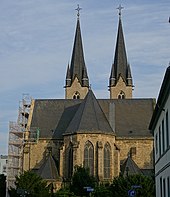
- Nicolaikirche in the New Neustadt , classicistic
- Reformation Church in Rothensee
- St. Ambrose Church in Sudenburg
- Saint Gertraud Church in Salbke
- Saint Gertrauden Church in Buckau .
Fortifications
The city's first fortifications can be traced back to the 12th or 13th century. At that time Magdeburg had a city wall surrounding it, which was located in the area of the northern old town between the Krökentor, Otto-von-Guericke Street and the cathedral. Between 1500 and 1550 the fortress was strengthened by roundels and bastions, the city wall got fortress towers, some of which are still preserved.
The Magdeburg fortress was almost completely destroyed in 1631, lost its independence and in 1666 was transferred to the Brandenburg garrison. Until 1740 the fortifications were expanded, expanded and reinforced. On the orders of Frederick II , Magdeburg was not expanded or maintained from 1740, which is why the weapons became obsolete and in 1806 they were forced to leave the city to the superiority of the Napoleonic army. However, the fortress was abandoned after only three weeks of siege. Only in 1812 and 1813 did the French strengthen the fortress again. In 1814 the fortress fell back into Prussian ownership after the Wars of Liberation.
With the construction of the Magdeburg – Leipzig railway line in 1838, the gates of the walls were let in. Due to the resulting vulnerabilities, 13 outer forts were built around the fortress in 1860 , to which six intermediate structures were added in 1890 . Although it was one of the strongest fortresses in Prussia from the beginning of the 18th century , it was abolished in 1912 due to its ineffectiveness.
- Selection of fortifications that still exist today
- Magdeburg Citadel - built in 1702, central part of the fortress, later also a feared prison in Prussia
- Ravelin 2 - built in 1700, independent fortress structure, protected trench sections between two bastions
- Barracks Mark - built in 1860, defense barracks, the last obstacle to the attack on the city, today it is a diverse cultural and conference center
- Kavalier "Scharnhorst" - built in 1873, served to protect the railway line Berlin – Biederitz – Magdeburg – Buckau and the bridge over the Stromelbe, briefly also a prison camp, today used for open-air events
- Bastion Cleve - southern fortifications on the Elbe, the central element is the “Cleve Tower”, which was exposed again in 2008 and freely accessible to visitors
- Lukasklause - late Gothic defense tower of the fortress, today Otto-von-Guericke Museum
- Kiek in de Köken - built in 1431, city wall tower of the medieval city fortifications
- various gates, including the Krökentor , Old Bridge Gate , New Bridge Gate , Buckauer Gate , Charlottentor or Cracauer Gate
- several forts, including Fort I , Fort Berge , Fort Ila, Fort III or Fort XII
- Turmschanze - Securing the Elbe crossing as an eastern bridgehead
- several rayon houses - houses that had to be destroyed in an emergency in the shortest possible time in order to get a clear field of fire for the defenders of the city
Profane buildings and other structures
In addition to the numerous sacred and fortress buildings, Magdeburg has many other buildings worth seeing. The Green Citadel of Magdeburg is one of the most interesting and is Friedensreich Hundertwasser's last architectural project . It was completed in 2005 in the Breite Weg near the cathedral, which is why the construction was not without controversy. Inside, it houses a hotel, rental apartments, shops, restaurants and cafes. There is also a theater in the green citadel.
The Magdeburg waterway intersection is located in the north of Magdeburg . After the first ideas of such a structure in 1877, it was completed over 100 years later, on October 10, 2003. The waterway intersection includes the important north-south connection Elbe and the equally important east-west connection consisting of the Mittelland Canal and the Elbe-Havel Canal . Further components of the structure are the more than 1 km long trough bridge that leads the Mittellandkanal about the same, the Rothensee economic sluice , the sluice Niegripp and the sluice Hohenwarthe .
The old town hall Magdeburg with the Ratskeller, built 1691–1698 and thus the most important building of this century, and the “new town hall” form the eastern boundary of the old market.
In December 1906, the Kaiser-Friedrich-Museum opened, today's Museum of Cultural History . The building was enormously destroyed in World War II and lost its characteristic, large tower on the corner of the building during reconstruction.
In the historicist style, the Magdeburg Regional Court was built from 1900 to 1906 (at that time the Palace of Justice). In 1945 the magnificent building was badly damaged and could not be restored until 2001. However, the destroyed part of the building was replaced by a modern structure. The four-storey building of the Justice Center Eike von Repgow was built from 1895 to 1899 and was also built in the style of historicism based on the style of the Dutch late Gothic and Renaissance .
The current seat of the Ministry of the Interior was built in 1913 as a representative police headquarters and was used as such until the 1990s. There was also a police prison there until the 1960s. The building has numerous architectural stylistic devices in the neo-baroque style.
The Palais am Fürstenwall was built in 1889-1893 by the architect Paul Ochs for the General Command of the IV Army Corps . Today the building is the state chancellery and seat of the state government of Saxony-Anhalt.
The Haus des Handwerks from 1901, formerly a sandstone building with many sculptures, which lost its representative form in 1945 due to an air raid, stood empty for a long time after the fall of the Wall. In 2012 it was restored for nine million euros and is again used as the headquarters of the Magdeburg Chamber of Crafts. There is also a restaurant in the building, which offers German cuisine on the one hand and exquisite international cuisine on the other.
The Kristall-Palast Magdeburg from 1889 was formerly a large concert and ballroom. In 1986, however, it had to be closed by the building authorities, as the building was in poor condition. Today it is left to decay or demolish. Nevertheless, an association was founded to fight for the preservation and renovation of the historic building.
In 1885 the castle-like manor house at Randau Castle was built in the late classical style. In the early 1990s it was supposed to be used for educational purposes, but this failed due to the insolvency of the investor. Today it is empty as no new investor could be found.
In 1902 the house of the Masonic Lodge "Ferdinand zur Glückseligkeit" was built, which was used from 1934 to 1998 by the city library. Its neo-baroque architecture shows clear influences of Art Nouveau in the sculptural facade decoration .
Another building steeped in history is the Society House in the Klosterbergegarten, built by Karl Friedrich Schinkel and reopened in 2005. With its large and small halls, it is a venue for concerts, exhibitions, conferences and much more.
The millennium tower in the Elbauenpark was built for the 25th Federal Horticultural Show in 1999 and, at 60 meters, is the tallest glued timber building in the world. Inside the tower is a museum that shows the history of science with vivid experiments.
The Hypar shell , built in 1969, was once a multi-purpose hall in the Rotehorn city park and an architectural model building for the city. The specialty of this building is that the construction is self-supporting. Today the building is empty, but efforts are being made to bring it back to life. Uses that fit into the concept of the city park, i.e. sport, leisure and family, are desired.
Another striking building is the Enercon administration building on the grounds of the Enercon Rothensee plant. The building, completed in 2006, was built in the shape of the typical Enercon wave.
Monuments and sculptures
The city has a large number of monuments, but unlike in other cities in Magdeburg you will find many of the sculptures in the city center.
The first to be mentioned is the Magdeburg Rider , erected around 1240, which is considered the first free-standing equestrian statue north of the Alps and of which a Playmobil figure was even made in a limited edition. The original is in the Kulturhistorisches Museum Magdeburg, a replica is on the Alter Markt. Emperor Otto I is likely to be depicted . The Magdeburg Roland is also on the Alter Markt, with a small figure by Till Eulenspiegel on the back . It was newly installed in 2005 at the entrance to the Ratskeller. In 2012, the historic triumvirate on the Alter Markt was completed with the re-erection of the deer column . The Magdeburg rider is supposed to symbolize the emperor's obligation to pay tribute, the Roland the striving of the city for independence and the stag embodies the promise of paradise.
The monument to Otto von Guericke from 1907 is located between the old and new town hall .
One of the most striking sculptures is the time counter on the town square on the Elbe. It is a large sphere with many clocks showing the times of the world's largest rivers. The current time is indicated by a figure sitting on the ball.
The figural staircase "Telemann and the four temperaments" was set up in 1981 next to the monastery Our Dear Women and shows the Magdeburg composer Georg Philipp Telemann , who is surrounded by four female figures who show the temperaments. A Gutenberg memorial was created in 1901 north of Universitätsplatz for the inventor of the printing press, Johann Gutenberg .
In Harnackstrasse there is a memorial to General von Steuben , who played a major role in the American War of Independence . The Luther monument stands in front of the Sankt-Johannis-Kirche , which is supposed to remind that he preached in this church on June 26th 1524 in front of a large crowd.
The Luis monument for Queen Luise of Prussia has an eventful history . In 1963 it was overturned from the pedestal and the statue then disappeared into a foundation pit of a dormitory. It has only been back in its original location since 2009, the Geschwister-Scholl-Park. A corresponding previously existing memorial to the popular Prussian queen was razed during the GDR era in the 1960s.
Other monuments would be, for example, the “Lazare Carnot Monument” in the North Park, the “August Wilhelm Francke Monument” also in the North Park, the “Mechthild von Magdeburg Monument” on Fürstenwall or the Kozlowski Monument .
Monuments and sculptures in the city invite you to take a tour of art in the public space of Magdeburg . The sculpture The Ferryman is located in the northern area of the Elbe promenade . It shows a ferryman on the one hand, and scenes from Magdeburg's history on the other. The Magdeburg Sculpture Park was created in 1989 and was initially limited to the area around the monastery of Our Dear Women. Today there are also sculptures north of the Hundertwasser House, on the banks of the Elbe, in the area of the Elbe railway station to the Magdeburg lift bridge and in the area north of the monastery complex. A total of 40 works by various artists are on display.
Cemetery facilities
Magdeburg has a total of 16 cemeteries, of which only 14 are burials.
The largest cemetery in Magdeburg is the Westfriedhof on Große Diesdorfer Straße. Its area is 62.5 hectares. It was opened in 1898 after two years of construction; the chapel was built in the neo-Gothic style. It contains numerous memorials, especially the war cemetery with the victims of the air raids on Magdeburg . Fallen Italian military internees are also remembered. Over 60 Soviet victims of the NKVD were buried in a mass grave at the end of the 1990s , probably killed in the 1950s.
The United Nations field in the Westerhüsen district is a burial site and memorial for victims of National Socialism . Once part of the Westerhüsen cemetery , a 1,500 m² piece was cut off in 1941 and used as a foreigner cemetery . After the end of World War II, the site was often redesigned. Presumably 766 people from 11 nations are buried there.
Squares and streets
Probably the most famous square in Magdeburg is Hasselbachplatz , which, along with Damaschkeplatz, represents a central connection node in local transport. In recent years the square has developed into the center of Magdeburg's nightlife with its many bars, pubs and restaurants. He is also known for the high proportion of well-preserved Wilhelminian-style houses.
Universitätsplatz is one of the most frequented places in Magdeburg. Originally it was a magnificent square with many imposing buildings, which were almost completely destroyed in World War II. Today the opera house , the university , the city library and other office buildings are located on Universitätsplatz. In addition to Deutsche Telekom , there are offices of IBM and the IT service company DATEV . The square is dominated by a tunnel for road traffic since 2006 B 1 under performs.
Ulrichsplatz is a green area in the city center, in the north-western part of which the Ulrich and Levin Church used to stand. The church, which was damaged in World War II, was demolished during the GDR era. Today the square is a recreational area and is known for its striking fountain. The square is surrounded by buildings in socialist classicism and the modern Ulrichshaus .
On the Elbe promenade is the place of the workers flag with a water feature and restored gauge house, which shows the current state of the Elbe. The square is also known colloquially as "Petri" and is always a meeting point for many young people.
In the place of the former Elbe railway station, the town square is now located in the center of the newly created district. Striking buildings are the large lift bridge , the Elbe balcony and the time traveler .
On the old market with the town hall and its "triumvirate", consisting of Magdeburg rider , Roland figure and deer column , other large events such as the European Festival or the Magdeburg Christmas market take place in addition to weekly markets .
The Domplatz is home to the Magdeburg Cathedral, a landmark of Magdeburg, as well as splendid baroque and modern buildings and is the city's oldest settlement center. Its most important buildings include the building complex adorned with a yellow and white baroque facade with the state parliament of Saxony-Anhalt , the Ministry of Justice and Equality and the headquarters of the Norddeutsche Landesbank . Due to the strongly economic and political environment of the Domplatz there are comparatively few cafes, restaurants and shops in its immediate vicinity, which is why it is more frequented by visitors to the cathedral.
Other important places in Magdeburg include Nicolaiplatz with the Nicolaikirche , Neustädter Platz with the fairy tale fountain , Schellheimerplatz, which is surrounded by many Wilhelminian-style houses, and Thiemplatz as the cultural center of Buckau .
Magdeburg's most famous street, the Breite Weg , was once one of the longest and most beautiful baroque streets in Europe, as well as an army and trade route, but was almost completely destroyed in the Second World War. Only the baroque buildings with street numbers 178 and 179 were spared from the bombs. It is now more shaped by modern buildings like the Allee-Center and the Green Citadel . The Breite Weg connects two of the most important squares in Magdeburg, the Universitätsplatz with the Hasselbachplatz, and is a pedestrian zone in the northern section.
Hegelstrasse near the cathedral was built in the early days of the Parisian era. It houses magnificent buildings such as the Palais am Fürstenwall , the seat of the State Chancellery and the Prime Minister of Saxony-Anhalt since 1990, and is one of the few streets in Magdeburg that is completely paved.
The Leiterstrasse, Magdeburg's smallest pedestrian zone and once an important shopping street, is one of the oldest streets in the city. It was largely destroyed in World War II. Today it houses restaurants, the Magdeburg Zwickmühle cabaret and the city's youth hostel.
The colorful Otto-Richter-Strasse in the Sudenburg district was awarded the German Facade Prize in 2004. The initiator of this street design is the architect Bruno Taut , who was elected Magdeburg's city planning officer in the 1920s. His job was to transform Magdeburg into a colorful city. Well-known artists like Carl Krayl designed many houses and streets. Not many of these colorful streets were preserved due to the destruction in World War II . Only the restored Otto-Richter-Straße is the last remnant of this architecture.
Important traffic arteries of the city are the Magdeburger Ring , built in the 1970s as an elevated road, and the city crossing B 1 .
Fountain
Magdeburg is home to a large number of fountains, one of the most monumental is the Hasselbachbrunnen on Haydnplatz. It stood on Hasselbachplatz until 1927, but had to give way for traffic reasons.
The Eulenspiegel fountain on the Alter Markt was set up there in 1970 and shows Till Eulenspiegel standing on a column above the Magdeburg people and mocking them. The Eisenbarthbrunnen , which shows Johann Andreas Eisenbarth ("Doktor Eisenbarth"), was built in 1939 . Similar to Eulenspiegel, Eisenbarth stands on a pillar, only in a barking pose.
On Ulrichsplatz there is one of the largest fountains at the end of the meadow. Very close by, on Leiterstrasse, first mentioned in 1263 and thus one of the oldest shopping streets in Magdeburg, is the Faunbrunnen , also known as the "Teufelsbrunnen". Figures, including people, animals, but also fauns , sirens and other beings cavort in and around a large bronze cauldron . The water feature on the Petriförder on the workers flag is also popular. Water sprays from five fountains onto a river-like watercourse that meanders through the square.
The Immermannbrunnen honors the playwright and writer Karl Immermann from Magdeburg . Scenes from his works are depicted on the fountain, with water flowing out of a fish's head. In the northern section of the Breite Weg there are some fountains from GDR times, for example a ball fountain, three bowl fountains, the fountain “Die Badende” and a drinking fountain. In Olvenstedt , a fountain was built that consists of a ball weighing tons that floats on a thin film of water and can therefore be moved. One of the most striking fountains is the Märchenbrunnen on Neustädter Platz, which is supposed to be reminiscent of Russian fairy tales and the shape of Russian basilicas.
In the course of the redesign of the cathedral square, the new light and water features were inaugurated in 2013. They consist of a total of 66 fountain nozzles and 33 mist nozzles, which emerge from the ground and spray the water in an arc shape into the air.
Magdeburg has an emergency well system , which consists of handle pumps designed according to historical models at various points in the city.
bridges
Magdeburg is divided into two large urban areas by the Elbe, with the city spreading more towards the west. The Marieninsel, on which the Rotehornstadtpark is located, is located between the urban areas . As a result, bridges have become an important part of the city over the years. Magdeburg has a total of 135 bridges, including 103 road bridges and 32 pedestrian bridges (as of 2009).
Magdeburg's oldest stone bridges from 1882, the Zollbrücke over the Zollelbe with its four allegorical figures, which was extensively renovated in 2006/2007, and the Anna-Ebert-Brücke , at the end of which a stone lion wearing a coat of arms sits enthroned, are the eastern extension of the Neue Strombrücke , which dates from 1965 and was not built with arches and pillars like its predecessors. Since the listed Anna-Ebert-Brücke is in a dilapidated condition, a cable-stayed bridge with a pylon on the west bank of the Old Elbe is being built in the eastern extension of the river bridge and the road over the Werder, the river bridge train.
The northern bridge section consists of the western, almost parallel to each other Jerusalem bridges, of which the south bridge called arched bridge built in 1952 as and North Bridge designated tied arch bridge dating from 1996 comes, and the bridges of peace , which also consist of two bridges, The southern one is a steel composite beam bridge from 1997 and the northern one is a prestressed concrete beam bridge from 1996. For car traffic, crossing the Elbe in the city area is only possible via the north bridge train or the river bridge train.
The Sternbrücke in the south of Magdeburg connects the old town with the Elbe island Rotehorn and the Rotehornpark. In its place stood the "Old Star Bridge", inaugurated in 1922, which was blown up in 1945 during the Second World War. Since 1991 there have been considerations for reconstruction, in 2005 the inauguration could finally take place in front of 100,000 people. It is used by pedestrians and cyclists, as well as public transport buses and taxis.
One of the largest lift bridges in Germany is the Magdeburg lift bridge from 1934. The single-track railway bridge was built in 1846/47 as a multi-part construction with a rotating middle section. Due to larger ships, the swing bridge had to be replaced by a lift bridge in 1895, which was replaced by the current design in 1934. It is no longer used as a railway bridge, but only as a pedestrian bridge. The middle section (span 90 m) has been permanently raised due to shipping traffic.
Another lift bridge is the lift bridge in the commercial harbor , which is the oldest of its type in Germany. Erected in 1894 for the port railway, it has since been shut down and is only a technical monument . It has been open to pedestrians and cyclists again since 2009.
Magdeburg's railway bridge over the Elbe, the Herrenkrug railway bridge , spans the area of the commercial port and was completed in 1979. It replaced a railway bridge built in 1873, which at low tide was an obstacle to navigation due to its pillars.
Other bridges are the Herrenkrugsteg , which has been providing a connection for pedestrians and cyclists across the Elbe to the Herrenkrugpark in Magdeburg Neustadt since 1999, the bridge at the waterfall near the Cracauer waterfall, also open to pedestrians and cyclists, and the Reyherbrücke, which crosses the Taube Elbe leads and which is a rare bridge construction, a fish belly bridge.
Museums
Magdeburg has a large number of museums with different collections and focuses.
The Kulturhistorisches Museum Magdeburg was opened in 1906 and deals mainly with the history and handicrafts of the city and the region. Exhibits worth mentioning are the original statue of the famous Magdeburg rider , of which there is also a limited Playmobil figure , and the monumental painting with scenes from the life of Otto the Great by Arthur Kampf in the Kaiser Otto Hall.
The Otto von Guericke Museum was opened in the Lukasklause in 1995 . It provides information about Otto von Guericke , shows replicas of devices such as a handheld fire syringe and the Magdeburg weatherman, and demonstrates experiments.
A specialty among the Magdeburg museums is the millennium tower in the Elbauenpark. The building erected for the Federal Horticultural Show in 1999 is the highest glued timber structure in the world at 60 meters. There are 6,000 years of science and technology history on display with several hundred exhibits and experiments. An astronomical telescope offers the opportunity to read the clock in Magdeburg Cathedral. A Foucault's pendulum illustrates the rotation of the earth.
The Museum of Natural History goes back to the Natural Science Association of Magdeburg, founded in 1869, which first housed the museum in a building on Domplatz. After its destruction during the war and the loss of numerous exhibits, the rescued exhibits were temporarily housed in the Kaiser Friedrich Museum . The city's oldest museum has around 250,000 objects from geology , mineralogy , paleontology and zoology .
In an old factory hall of the former Krupp Grusonwerk, which is under monument protection, is the Technikmuseum Magdeburg with exhibits of drive and machine tools, printing technology, locking technology and traffic, including the first Magdeburg tram from 1899 and the airplane by Hans Grade , which he rode in 1908 made Germany's first powered flight on the Cracauer Anger .
The art museum Kloster Unser Lieben Frauen in a former monastery from the 11th and 12th centuries and thus one of the oldest buildings in the city is the most important exhibition space for sculptures from ancient, medieval and modern times and for other contemporary art in Saxony-Anhalt.
Attached to the Magdeburg puppet theater, the villa p. a collection of figures and games which, with over 1,000 dolls and objects, spreads the history of puppetry against the background of the various social systems on 600 m².
The circus museum deals with dressage , artistry , clowning and variety , the hairdressing museum with the history of the hairdressing trade and a historical hairdressing salon from 1929. Also to be mentioned are the museum ship Württemberg , the historic ship mill on Petriförder, the open-air museum Steinzeithaus Randau with a replica 4500 year old post house excavated there and a clay oven as well as the Slavic village Pechau , which shows the settlement of the East Elbe region from the 8th to the 12th century. In the Sudenburg museum depot there are currently 15 different historical trams on display, but they also offer tours on several routes.
In 2014 Magdeburg's first GDR museum apartment opened in Hohenpfortestrasse in a Q6 block residential building. The museum apartment consists of three rooms, a kitchen, a bathroom and contains over 1,000 original exhibits from the GDR era.
The Sudenburg museum depot houses historic Magdeburg tram cars . Cultural events also take place in the depot.
The Dommuseum Ottonianum Magdeburg was opened in November 2018 .
Galleries
Magdeburg is home to galleries whose exhibitions show contemporary art, paintings, graphics and sculptures, photographs and printing technology. In addition to the permanent exhibitions, there are regular exhibitions by national and international artists in various public or private spaces in the city.
Permanent galleries in the city:
- Art Depot - predominantly works by international, mostly Eastern European, artists
- Galerie Himmelreich - mainly artists from Saxony-Anhalt or other national artists
- Flurgalerie Eisenbart - special support for young artists
- Gallery of living Art - interactive gallery, mainly run by students
- HO gallery
- Gallery South in the "Feuerwache" cultural center
- Burggalerie Magdeburg
- Art workshop
- Aerosol-Arena - largest legal Hall of Fame in Germany in a 30,000 m², fallow building complex in the old industrial port of Rothensee ; through the specially created association “Freiluft-Atelier e. V. “released for all graffiti and street artists; a special feature are the walls, which are up to 60 × 2 m in size; In the future, train wagons are to be set up there, making the area the world's first Wholecar yard.
Theater and opera
The Magdeburg Theater , a four-branch theater with its own ensembles in the field of music theater, philharmonic orchestra, ballet and drama, maintains two theaters in Magdeburg, on the one hand the traditional opera house on Universitätsplatz for music theater, ballet and concerts with a large stage, other small stages and a podium and on the other hand the theater in Otto-von-Guericke-Straße with a large stage, studio and foyer.
In 2013 over 175,000 visitors attended the events of the Magdeburg Theater. One of the most popular events in the summer is the Domplatz Open Air with almost 23,000 visitors. This means that the theater's occupancy was more than 80%.
The music theater division is covered by the Magdeburg Opera. An efficient opera ensemble, the Magdeburg Ballet and the nationally recognized Magdeburg Philharmonic are housed here. In addition to major operas and symphony concerts, operettas, musicals, literary ballets, theater evenings, tabloid comedies and small forms of opera are also performed. There are also programs in the “Cafe Rossini”, performances by Germany's largest theater youth club, freijungundwild, in the “Podium”, special events, opera balls and galas and prominent guest artists.
The theater division is occupied by the Magdeburg theater. It is housed in the Schauspielhaus Magdeburg, theater literature of different times and genres, especially contemporary domestic and foreign drama, are performed. The pieces include many world premieres and German-language premieres. In addition to the normal performances, the Magdeburg Theater also offers varied events such as "Jazz in the Chamber" under the direction of Warnfried Altmann , Magdeburg's most famous jazz music, or "Night Shift", where shows and pieces from literature, music, dance and mix are presented .
The Magdeburg Puppet Theater from 1958 is one of the largest and most modern puppet theaters in Europe. It has a large hall with over 140 seats and a small one with 60 seats and the latest stage technology, a rehearsal stage and other small stages. It offers age-specific productions for all age groups from kindergarten to adulthood. The puppet theater also has its own youth art school. It is the last independent city theater in Germany with a focus on puppetry.
The "Magdeburg Children's Culture Days" or the international puppet theater festival "Blickwechsel" take place every year, attracting more than 10,000 spectators from all over the world to the city. In 2012 the puppet theater opened a permanent exhibition in a neighboring, renovated half-timbered villa (villa p.), Which uses a collection of figures to present the history of puppetry from its origins to the present day.
In 1992, the idea of Ines Lacroix and Matthias Engel gave rise to the “Theater an der Angel” with more than a dozen productions and space for around 100 people in the hall. The theater is supported by veteran Peter Wittig. Happy, comedic or thought-provoking pieces are played.
The improvisational theater "Herzsprung" is a small theater group that presents its plays with rough descriptions, but takes inspiration from the audience while they are playing. In this way they develop spontaneous stories and scenes without a script or director. Further improvisation groups from Magdeburg are the groups “Change of scenery”, “Kammerjäger” and “Imaginär”.
In the Green Citadel , the "Theater in the Green Citadel" has formed. It is a mix of theater, show, music and comedy, cultural events in Magdeburg are to be brought onto the stage. It is the only theater in the world that can be found in a Hundertwasser house. There is space for up to 200 spectators in the theater room, and exhibitions, readings and events take place here.
The " MS Marco Polo ", based in Schönebeck, has been used by various ensembles as a theater ship under the name Theaterschiff Magdeburg since 2009.
cabaret
In Magdeburg there are two standing cabaret venues and some off groups and soloists who offer political-satirical cabaret:
- The Magdeburger Zwickmühle plays with its own ensemble in the theater in the Leiterstrasse and is known in the entire German-speaking area, on the one hand for its numerous prizes and on the other hand for the MDR television program “Die 3 von der Zankstelle”. They have already made guest appearances all over Germany, Switzerland and Stockholm.
- “Die Kugelblitze” are a cabaret group consisting of three cabaret artists who are currently showing their pieces as permanent guests in the Magdeburg Zwickmühle.
- The cabaret "... nach Hengstmanns" with the Hengstmann brothers Sebastian and Tobias Hengstmann and their father Frank Hengstmann and Bernd Kurt Goetz has been located in the Breite Weg in Magdeburg since 2008. In addition to the usual political satire, the pieces are often based on the family relationship between the two brothers.
- In addition , Lothar Bölck and the student cabaret "Prolästerrat für Studienunelektiven", founded in 1972, play in the Magdeburg fire station , a socio-cultural center of the city .
- The Trio Po-Ente has been enriching the Magdeburg cabaret scene since 2013 . Your stage is in the Club Kiste on the medical campus of the university clinic.
Leisure and Tourism
In 2015 there were 569,791 overnight stays in Magdeburg, including over 74,333 from abroad. Thus Magdeburg is among the 40 most visited German cities. The state capital was able to increase the number of overnight stays by almost 50% compared to the record low in 2000.
In June 2015, the Magdeburg hotel landscape consisted of 43 accommodations with a bed capacity of around 5,200 beds, with an occupancy rate of around 40%. The average length of stay for hotel guests from Germany is 1.6 days and that of guests from abroad 1.7 days. The Maritim-Hotel and the Herrenkrug Parkhotel on the Elbe are among the largest and most elegant hotels in Magdeburg . Magdeburg Marketing Kongress und Tourismus GmbH (MMKT GmbH) is mainly responsible for the marketing of the city of Magdeburg .
Magdeburg is part of several tourist travel routes. The 1,200 km long Elbe cycle path, one of the most popular cycle paths in Germany, leads through the city along the Elbe . A large number of buildings from the Middle Ages can be visited on the Romanesque Road . The north and south routes of the Romanesque Road meet in Magdeburg.
The city is also located on the Blaues Band water hiking route , which runs along the Elbe and is part of the Garden Dreams Saxony-Anhalt , a state-wide network for the rediscovery of historic parks and gardens. In addition, there is the “Straße der Technik” in Magdeburg, which provides information about the engineering structures in the region, including the last operational two-float lift in Europe, the tanner's trade that has existed since the 13th century , the last original to have been preserved Telegraph station in Germany and the formerly longest straight graduation tower in Europe.
The most famous recreational facilities include the Gruson greenhouses , a botanical garden with almost 5,000, mostly exotic plants, an aquarium, some reptiles ( caimans , chameleons , geckos , turtles ), amphibians (poison dart and clawed frogs) and a group of free-range ostrich quail .
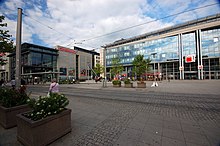
In addition to the large Nemo adventure pool, there are other swimming pools and open-air pools in Magdeburg, including the Elbe swimming pool , which is also part of the national swimming pool, the Olvenstedt swimming pool, the north swimming pool, the Große Diesdorfer Straße swimming pool , the Carl-Miller-Bad, the Outdoor swimming pool south and the Erich-Rademacher-Bad. In the diving center Magdeburg diving courses and diving trips are offered.
The largest lakes in Magdeburg are the Barleber Lakes , the Salbker See I , the Salbker See II , the Adolf-Mittag-See with pedal boat rental and the Neustädter See as a bathing lake with a water-ski facility "Cable Island".
The Elbe is important for water tourism. Their use as a waterway is declining. There are now more sport boats and passenger ships than freight ships. In 2014, 1,823 freight ships with 0.421 tonnes of cargo, 1,610 passenger ships, 3,089 pleasure craft and 544 other vehicles (e.g. police, THW) were counted on the Magdeburg city route. In 2016, the number of freight ships continued to decline; the amount transported fell to 0.3 million tons. In contrast, the use of passenger shipping is increasing . According to estimates by the Blaues Band association , between 350,000 and 400,000 tourists were transported on the Elbe in 2016.
On the Elbe and the Old Elbe there are sandy beaches of around 20 km in length , which come to light between the groynes and inner curves , especially when the water is usually low in summer . As a result of the discontinuation of industrial plants and the construction of sewage treatment plants after 1990, the water of the Elbe is clean again and is of bathing water quality with visibility depths of more than one meter. Magdeburg is the only city on the Elbe where bathing in the Elbe is prohibited. For the implementation of the Elbe Bathing Day, which takes place in July on the Old Elbe, a special permit has usually been granted so far.
Magdeburg's large cinema complexes are the Cinemaxx cinema in the city center and the Cinestar cinema on Pfahlberg on BAB 2 . The smaller cinemas include the studio cinema, the Oli Lichtspiele, the Scala-Filmtheater Sudenburg and Magdeburg's smallest cinema, the Moritzhof cultural center. In summer there are also some open-air cinemas, the largest being the SWM City Summer Cinema in the city park.
The Elbauenpark , built for the Federal Horticultural Show in Magdeburg in 1999, includes a natural playground, a 40 m long summer toboggan run, a 25 m high climbing rock, a frisbee disc golf course, a fitness and skate course, a high ropes course, a maze, and a butterfly house with over 250 butterflies in 20 species and the millennium tower with an exhibition on the development of science.
Another adventure park is the Herrenkrugpark with the Magdeburg exhibition center , a golf course, the Herrenkrugwiesen racecourse and the Nemo adventure pool.
The monastery garden with the society house is the first public garden in Germany.
Among the various bowling facilities in the city, Bowling World Magdeburg is one of the largest with its 30-lane bowling facility, billiard tables, table tennis tables, numerous video game machines and its own sports bar.
There are around a dozen skate parks and dirt parks in Magdeburg. The most famous facilities are the modern skatepark built in 2013 in the Rotehorn city park and the M-Trails dirt park between the old town and Stadtfeld Ost. The city also has indoor and outdoor cross tracks, the Magdeburg motocross track and the Magdeburg SX motocross hall. The Rennring Magdeburg in Buckau is a 500 m long indoor go-kart track, the largest go-kart track in Saxony-Anhalt.
In the adventure park Magdeburg you can try out the handling of the various construction machines on a sand area of over 130,000 m² with large and small crawler excavators , mini excavators and small and large wheel loaders .
Major sports facilities in the city are the MDCC-Arena , the Heinrich-Germer-Stadion , the GETEC Arena and the Hermann-Gieseler-Halle . Aviation is also carried out at the Magdeburg airfield .
Zoological Garden
The 16 hectare Magdeburg Zoo is home to around 1400 animals in around 210 species. It is located in the bird song park Neue Neustadt . Over 300,000 visitors visit it every year. It is currently being converted from a “classic zoo” into an adventure zoo. The zoo is involved in over 43 conservation breeding programs and international stud books. In facilities such as the giraffe house, ape house, meerkat enclosure or in the petting enclosure, visitors should be brought relatively close, but safely, to the animals, with the animals living in species-appropriate environments.
It is open 365 days a year and closes in the evening when dusk sets in.
Parks and gardens
One of Magdeburg's most popular parks is the Elbauenpark , where the Federal Garden Show took place in 1999 . According to Stern magazine, it is the best leisure attraction in Saxony-Anhalt. Its main attractions include the butterfly house, the 14 themed gardens or the maze. It also offers many other family-friendly attractions, such as the climbing tower, the millennium tower, the summer toboggan run or the climbing park. The Herrenkrugpark , which is one of the most beautiful and natural parks in the city, is just as popular . The largest park in the city is the city park Rotehorn , in which the city hall , the Hypar bowl , the observation tower , the horse gate or the Fort XII are located. These three parks and the Klosterbergegarten , the oldest public park in Germany, are part of the Garden Dreams Saxony-Anhalt network .
The renatured Glacis fortress, which once surrounded the city center, is divided by the Magdeburger Ring. The Vogelgesangpark with its large parks and many individual gardens is located near the zoo .
Further facilities in Magdeburg are the Goetheanlagen, the Volkspark Westerhüsen , the Amtsgarten Ottersleben , the Florapark , the Nordpark , the Geschwister-Scholl-Park , the Schneidersgarten as Magdeburg's smallest park, the Fürstenwall , the Gutspark Benneckenbeck, the Hohepfortewall, the material plant and the Elbe promenade in the old town and Buckau area.
Venues
Magdeburg offers a wide range of venues that are used for concerts, sporting events, dance events, lectures, conferences, assemblies and much more. The GETEC Arena , formerly Bördelandhalle, is a very modern and the largest multi-purpose hall in Saxony-Anhalt. In addition to sporting events, concerts and television productions take place there. Other large halls in the city are the city hall with space for over 4,000 spectators, the AMO culture and congress house or the Magdeburg trade fair . Venues with medium-sized capacities include the Johanniskirche , the “Georg Philipp Telemann” concert hall in the monastery of Unser Lieben Frauen, the floating stage in the Elbauenpark, the Pauluskirche (regular performance location of the Magdeburg cantata choir) or the society house built by Friedrich Schinkel in the monastery garden with its halls of various sizes . In addition to the larger facilities, there are also smaller institutions for live concerts in Magdeburg such as the “Thiem 20 - House for Young Art”, the Moritzhof , a listed four-sided courtyard , the Gröninger Bad , the KJFE Knast or the KJFE HOT - Alte Bude .
nightlife
In addition to live concerts, Magdeburg's nightlife mainly consists of dance events in larger discos and smaller clubs. What is striking about Magdeburg is that many of these event locations are located in former fortresses and industrial plants that have been vacant since the fall of the Wall.
Some of the larger discos are the Mark Fortress , which provides electronic music events as well as cultural events, and the Old Theater on Jerichower Platz. The former factory hall Factory in the south of the city also offers an industrial feeling , where German and international pop, rock, metal and indie bands regularly play and disco events take place. The city's finer clubs include the Prinzzclub and First , which offer a mix of lounge and club. At the age of 45, the Baracke student club is the city's oldest club and is located directly on the grounds of Otto von Guericke University. As an equivalent, there is the box for students of the medical faculty on the campus of the university hospital . There are also other medium-sized and smaller discos and clubs, such as Boys'n'Beats , the Alte Feuerwache , the Kunstkantine or the Triebwerk . Mention should also still a beach-inspired clubs beach directly on the Elbe, one of the first City Beach Concepts of Germany, and the Montego Beach Club in the city park Rotehorn with volleyball courts and large pool.
In 2016 and 2017 some discos were closed. Until 2016, the large disco Music Hall , the former fun park , was located in the south of the city and served not only mainstream genres but also special music styles. In addition, the disco tower Nautica (Pearl Club) was closed in 2016 after the water park changed operator after bankruptcy and was rebuilt. At the beginning of 2017, the Kulturwerk Fichte , a listed industrial hall from the early days, where scene parties and other large events took place, was finally closed.
The Hasselbachplatz on the southern town has evolved in recent years to Magdeburg pubs center. Due to the high level of traffic during the day, but especially in the evening hours by visitors to the numerous clubs, bars and pubs, the square is classified as a focus of crime and is monitored by video technology.
Sports


Around 170 regionally, nationally and internationally successful sports clubs are based in Magdeburg. These include 1. FC Magdeburg or SC Magdeburg . These and other clubs have produced more than 100 athletes in the last 100 years, who have brought over 400 medals to Magdeburg in European and world championships, at the Olympics and through world records. Germany's first “Sports Walk of Fame” was created for them in 2007 in Breiten Weg, where the city honors the athletes by laying floor tiles with incorporated names, sporting performance and their year.
Magdeburg is one of the two Olympic training centers in Saxony-Anhalt. The cross-sport support and service facility aims to promote top and young athletes in Olympic sports. Together with the sports high school Magdeburg and the sports secondary school "Hans Schellheimer" they form the center for sports training and the promotion of young talent in Magdeburg.
1. FC Magdeburg plays in the third division in the 2019/20 season and plays its home games in the MDCC Arena . With numerous titles in the past, it is one of the most successful football clubs in the GDR . The Magdeburg FFC , a women's football club, currently plays in the Regionalliga Nordost . Magdeburg is also the seat of the Saxony-Anhalt Football Association .
The SC Magdeburg has one of the most traditional swimming sports departments in Germany and has one team each for men and women in the 1st swimming division . The Elbe swimming pool is the training and competition venue . The athletes ' and rowers' departments are also extremely successful and have won numerous titles at Olympic Games and championships. The most successful department of SC Magdeburg, however, are the canoeists with several world champions and Olympic medalists.
The handball department of SC Magdeburg plays in the handball Bundesliga and is one of the most successful German handball clubs. It was the first German club to win the handball Champions League in 2002 . The home venue is the GETEC Arena , which holds around 7,000 spectators. The second team, called SCM Youngsters , plays its third division games in the Hermann-Gieseler-Halle .
Magdeburg has owned East Germany's only professional boxing stable , SES Sport , since 2000 . He is the third largest German boxing promoter and works closely with Universum / Spotlight . There are several world champions among the team's 15 active boxers.
Also water polo has a long tradition in Magdeburg. The Wasserball-Union Magdeburg played in the Wasserball-Bundesliga (DWL) until relegation in 2013 .
The 1st team of basketball players "Otto Baskets" from BBC Magdeburg is currently playing in the 2nd Bundesliga ProB . It plays its home games in the Hermann-Gieseler-Halle.
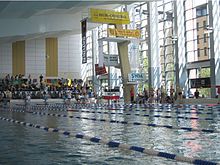
The American Footballers of the "Magdeburg Sports Club '90", the Virgin Guards , played in the German Football League 2 until 2011 . The venue is the Heinrich Germer Stadium . In 2011 the final of the German Football League , the German Bowl , was played in the MDCC Arena in Magdeburg .
In April 1994 the “Magdeburg Poor Pigs” were founded, a baseball and softball team. After winning the Central German Championship in 2015, they play in the Regionalliga Nordost in 2016. The Poor Pigs play in the Westerhüsen district on the “Tonschacht” sports complex, which opened in 2010 and corresponds to international pitch dimensions.
The Magdeburg Marathon has been held annually through the city of Magdeburg since 2004 . You can choose between the 42 km long marathon route, the half marathon route, the 10 km (until 2014: 13 km) long route or the mini marathon route. Start and finish is always the Magdeburg trade fair .
Horse races also have a long tradition in Magdeburg. Horse racing events have been taking place on the Herrenkrugwiesen racecourse since 1838. There are at least 4 races every year.
Several aerial sports take place at Magdeburg Airport, including, for example, parachuting and gliding . The airfield is the seat of the FSV Magdeburg association . In 1968 the world championships in motor aerobatics took place at this airfield .
Regular events
spring
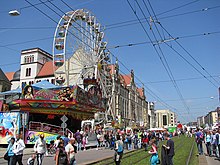
The Magdeburg Spring Fair , a three-week hype at the beginning of spring, takes place annually at the “Max Wille” exhibition center on the Kleiner Stadtmarsch directly on the banks of the Elbe. Since 2010 the RoboCup German Open has been held in the Magdeburg exhibition halls in March / April . Thousands of visitors follow international teams in various disciplines, including robot soccer , competing with their robots.
The Day of Thunder has been held at Magdeburg airfield every year since 2000 . In 15 different racing classes, different types of mopeds, motorcycles, cars and quads compete against each other in a 1/8 mile race . In addition, competitions such as “Best of Show”, “Most Beautiful Overall Concept”, “Best Paintwork”, “Best Interior”, “Best of Sound”, “Best of Exhaust” and a “dB Sound Contest” take place on a show stage.
The Magdeburg historical spectacle Spectaculum Magdeburgense in May in the area of the old fortifications is a medieval event. Numerous events and activities, including for example fakir shows, theater events, a medieval market and musical sounds from this time, entertain the visitors. Every year on Ascension Day the festival of encounters against xenophobia takes place in Rotehornpark .
summer
In addition to the cloister serenades in the cathedral, the nationally known summer open-air of the Magdeburg Theater takes place on Magdeburg Cathedral Square in July / August .
The BallonMagie -Tage in Elbauenpark is held annually in August. Several hot air balloons start at the same time and enrich the Magdeburg sky. Special forms such as ice cream cones, sausage tins or airships are represented among the balloons.
The Christopher Street Day , also in August, is a festival of lesbian , gay , bisexual and transgender people . There will be demonstrations for the rights and against the exclusion of these groups. It takes place in numerous cities in Germany. The parade stretches from Neustadt train station through the city center, Hasselbachplatz into Liebigstrasse.
The three-day Kaiser Otto Festival has been taking place around the historic quarter of Magdeburg Cathedral every year since 2011 , at which buildings and places such as the Cleve Bastion , the Monastery of Our Lady , the Möllenvogteigarten , the Fürstenwall or the cathedral itself are venues for medieval attractions, performances and Pageants such as Otto I's coronation as emperor , knight tournaments, falconry shows and medieval chants. The festival is intended to remind of the importance of the city of Magdeburg as the cradle of the German nation and European history.
The bicycle action day takes place once a year. After a rally to the meeting point, a large bicycle demonstration leads across the city and over the Magdeburger Ring. The cyclists want to show their colors and advocate a more bicycle-friendly city. In 2014 it took place for the fourth time on June 28th.
autumn
In September the State Harvest Festival, with over 35,000 visitors the largest public event for the agricultural profession in Saxony-Anhalt, is celebrated in the Elbauenpark in Magdeburg. In addition, there is the DIAGONALE jazz festival, the literature weeks, an event for literature lovers with many offers and exhibitions, lectures and performances, the Magdeburg art festival, the OMMMA ( Ostmobil-Meeting Magdeburg ) and the Magdeburg Autumn Fair (formerly men's fair ), a three-week hype that takes place at the beginning of autumn on the “Little City March”. In 2010 it celebrated its 1000th anniversary, because it originated in the holy festival of the Theban Legion of Archbishop Tagino , which was celebrated on September 22, 1010. From 1220, the festival of Mauritius and his holy comrades-in-arms merged with the great Magdeburg fair, which at that time still took place on Domplatz. Thus the autumn fair Magdeburg is today the oldest folk festival in Germany.
winter
The biggest event of the year is the Magdeburg Christmas market with around 135 stalls. It attracts over 1.5 million visitors every year, takes place on the Old Market and offers many attractions, for example daily live music, a Santa Claus consultation hour, fairytale performances and the historic Christmas market. It is considered one of the most child-friendly Christmas markets in Germany and is the longest open Christmas market in Germany every day.
In January, the so-called Mile of Democracy takes place annually with over 10,000 visitors, with the Breite Weg up to Hasselbachplatz being the venue for this event with numerous activities, information stands, discussion hours and an extensive stage program. It was created to take the place of the simultaneous march of right-wing extremists . They use the anniversary of the air raids on Magdeburg on January 16, 1945 as an occasion for a funeral procession, and to equate the victims with the Holocaust and those murdered in the concentration and extermination camps, thereby playing down the National Socialist mass murders.
music
In Magdeburg, numerous different music events take place throughout the year, including many in honor of the Magdeburg baroque composer Georg Philipp Telemann . Since 1990, the Magdeburg Telemann Festival has been held on even years in March / April , which consists of performances and interpretations of the composer's works. Part of this is the musicology festival , the international scientific conferences , the Telemann academies for music students and young musicians and the opera academy "Georg Philipp Telemann: The patient Socrates" . The International Telemann Competition has been held on odd years since 2001 and calls on participants between 18 and 34 worldwide to play works by Telemann and his contemporaries on historical instruments or copies. The concert series “Sunday Music”, initiated by the Magdeburg Friends of Telemann, has taken place on the first Sunday of each month since November 1961 (exception July / August). The focus of the concert programs is on the chamber music of Telemann and his contemporaries. Telemann's church music also comes into focus.
Another musical event is the organ festival on the three largest and most important organs in the city, namely the Jehmlich organ in the monastery of Our Lady , the Eule organ in the St. Sebastian Cathedral and the large Schuke organ in Magdeburg Cathedral .
The Magdeburg Song Days also take place in spring , when interpreters perform and give concerts at various locations in the city over several days.
The fairly manageable jazz scene in Magdeburg still offers events throughout the year. The Open Air New Orleans Jazz Festival has been held since 1995 . The Herrenkrugpark will be transformed into a large stage, and jazz artists will perform , entertaining around 15,000 visitors. Other events are jazz! in the Schauspielhaus , the Kunst Kultur Karstadt , the guitar nights of the Jazz AG, the DIAGONALE and from autumn 2015 the Magdeburg Jazz Days .
A special highlight of the year is the Fête de la Musique Magdeburg . Over 150 bands and solo artists perform in front of thousands of spectators every year on eleven stages throughout Magdeburg's city center and in the Rotehorn city park . The events are free for the public. The Fête de la Musique takes place in over 500 cities worldwide.
A young talent competition in Saxony-Anhalt is organized by Stadtwerke Magdeburg and is looking for musical talent from Magdeburg and the surrounding districts. The SWM TalentVerstärker has been taking place since 2002, until 2013 under the name SWM MusiCids , and offers talents the first step to start a career. The most famous example is the band Devilish , which later became known as the world famous Magdeburg band Tokio Hotel .
Culinary specialties
Local culinary specialties include “Bötel”, pork knuckle with sauerkraut, pea puree and boiled potatoes, “ minced meat ”, a dark sauce with mixed minced meat that is eaten with potatoes, and “ Pottsuse ”, a spread made from pork , lard and some spices as well "Bollenwurst", a hearty onion liver sausage.
Great shopping
The traditional shopping miles include the 2.2 kilometer wide Breite Weg , which ends in the equally popular Hasselbachplatz , the Leiterstrasse and the Ernst-Reuter-Allee . There are other major shopping streets in Neue Neustadt and Sudenburg , among others . Nevertheless, there are significantly fewer historically grown retail structures than in other cities of the same size.
Magdeburg is more shaped by shopping centers that were largely built after the fall of the Wall . The Allee-Center , City-Carré , Ulrichshaus and the Karstadt and Papenbreer department stores are located in the city center . Located on the outskirts are the Bördepark in the south of the city near the airfield and the Florapark in the north-west of the city, the largest shopping center in Saxony-Anhalt. As a result, Magdeburg's residents, together with a diverse landscape of supermarkets, discounters and department stores with 2.5 square meters of retail space per inhabitant, have a top position in Germany.
Stumbling blocks
So far 61,000 stumbling blocks have been laid worldwide to commemorate the fate of the people who were murdered under National Socialism . So far 497 such stones have been laid in the city of Magdeburg. (As of September 2017)
Hemispheres
On the occasion of Otto von Guericke's 400th birthday in 2002, 40 pairs of hemispheres were designed by artists and laypeople and placed in various locations in the city. The four-foot-tall hemispheres made of glass fiber reinforced plastic are reminiscent of Guericke's famous physical experiment in 1656. Some of these hemispheres can still be seen in the city today.
Economy and Infrastructure
In 2016, Magdeburg achieved a gross domestic product (GDP) of € 7.813 billion , making it 47th in the ranking of German cities by economic output . The share in the economic output of the federal state Saxony-Anhalt was 13.2%. In the same year, GDP per capita was € 32,978 (Saxony-Anhalt: € 26,364, Germany € 38,180). In 2016 there were around 137,700 gainfully employed people in the city. The unemployment rate was 8.2% in December 2018.
In the Future Atlas 2016, the urban district took 224th place out of 402 districts, municipal associations and urban districts in Germany and is therefore one of the places with a "balanced risk-opportunity mix" for the future. In the 2003 edition, Magdeburg was still 353 out of 434.
Industry

Magdeburg is one of the oldest industrial centers in Germany, which is due to the favorable traffic situation at the intersection of Germany and Europe with important traffic arteries and which is due to the great fertility of the soil west of the Elbe and the mineral treasures in the Magdeburg area, z. B. salt, potash and lignite. Until the 19th century, trade and traffic on the Elbe were based on privileges such as stacking, market, customs and coinage rights.
Well-known mechanical engineering companies settled here. For example, the “Magdeburger Dampfschiffahrt-Companie” and the machine factory “Alte Bude” opened in 1828. With the expansion of the rail network in Magdeburg, the economy grew increasingly. In 1850 Bernhard Schäffer founded the fittings factory "Schäffer & Budenberg", in 1855 Hermann Gruson the "Machine Factory and Shipbuilding Workshop H. Gruson Buckau -Magdeburg" ( Grusonwerk - from 1893 subsidiary of Friedrich Krupp AG ), Rudolf Ernst Wolf opened a machine factory in 1862 (1928 Fusion to Maschinenfabrik Buckau R. Wolf ), which became one of the leading ammunition factories alongside Armaturenfabrik Polte , and in 1886 Fahlberg-List started the world's first saccharin production . In the so-called early days of the 19th century, other companies settled in Magdeburg.
These companies formed the foundation for the "city of heavy engineering", as Magdeburg was called in the GDR. In mid-1946, the Grusonwerk was initially a Soviet joint-stock company , at the end of 1953 with 11,500 employees it became the VEB heavy machinery construction " Ernst Thälmann " and finally in 1969 the heavy machinery construction combine "Ernst Thälmann" (SKET). In 1990, many companies expropriated in 1972 could be run again in private hands, but in the course of the fall of the Wall the large industrial combines collapsed. Smaller industries remained or developed.

Nowadays there are also new companies in the mechanical engineering sector, so that this sector in Magdeburg u. a. plays an important role with large factories of the companies SKET, FAM Magdeburger Förderanlagen und Baumaschinen GmbH or Euroglass . Magdeburg, with several Enercon subsidiaries, is an important production location for wind turbines . Vestas produces cast parts in the city.
Agriculture benefits, as it has for centuries, from the soil of the Magdeburger Börde, a soil with the best soil quality, which is a prerequisite for the food industry. It is also necessary for the production of renewable raw materials such as rapeseed, from which biodiesel is obtained. Due to the fertile soil and clear spring water of the heather, Magdeburg developed into a stronghold of beer brewing in the late Middle Ages, which was operated in the local monastery of Our Lady as early as the 11th century. In 1309 a civil, commercial brewery in Magdeburg was first mentioned in a document; Around 1500 there were around 500 breweries in Magdeburg that sold their beer as far as Bavaria. With the switch to industrial brewing, this situation changed quickly; numerous breweries were closed. The later diamond brewery , founded in 1841, however, relied on the new organizational forms.
The Schuberth GmbH , one of the world's leading manufacturers of head protection systems, in 2009 moved its headquarters with administration and production of Braunschweig to Magdeburg, and has around 350 employees.
The Abtshof Magdeburg is a manufacturer of spirits and is known nationwide for its absinthe . As the first company in Germany, it has been producing kosher spirits since 1993 .
The company Röstfein , founded in Magdeburg in 1908 , is the only coffee manufacturer in the new federal states and employs around 150 people in Magdeburg.
The Glencore Magdeburg GmbH (formerly Prokon -Bio oil Magdeburg) issues rapeseed biodiesel , Rapsölraffinat, pharmaceutical glycerine, rapeseed meal and edible oils ago. The company, which has consisted of three oil plants since 2012, processes around 700,000 tons of rapeseed per year, from which around 233,000 tons of oil are extracted. This makes Glencore Magdeburg one of the largest oil mills and biodiesel producers in Europe.
The most important branches of industry in Magdeburg are machine and plant engineering, environmental technologies, health management, recycling management, processing of renewable raw materials and logistics. The service sector for the telecommunications sector has grown strongly since the 2010s and all major providers that operate in Germany have projects in technology or customer service here. The scientific community is also developing and, in addition to the two universities, includes various research institutes.
In the last 20 years the service sector has developed significantly and is becoming more important as an employer. For example, T-Systems operates its largest data center with around 750 employees in Magdeburg. In addition, the US IT group IBM opened its first service center in Germany in the state capital. It is to become part of the worldwide network of a total of 32 IBM centers. By 2015, around 300 employees are to work here in the areas of software consulting and development. The central location with several universities and colleges in the area, but also the proximity to important companies, was particularly decisive for the choice of location in Magdeburg.
- Largest employer in the state of Saxony-Anhalt based in Magdeburg, measured by the number of employees (as of December 2013)
- Deutsche Bahn AG (7835)
- EDEKA stores (4352)
- regiocom GmbH (1483)
- Magdeburg conveyor systems and construction machinery GmbH (1389)
- Bosch Communication Center Magdeburg GmbH (1075)
- The private employment agency & personal leasing GmbH (757)
- Municipal Works Magdeburg GmbH (739)
- Magdeburger Verkehrsbetriebe GmbH (700)
- GETEC Energie Holding GmbH (621)
- reinEX Services GmbH (608)
- STRABAG AG (520)
- Rothenseer Rotorblattproduktion GmbH (461)
- Stadtsparkasse Magdeburg (432)
- NORD / LB Landesbank for Saxony-Anhalt (396)
- MDR (382)
- SKET GmbH (342)
traffic
The modal split , i.e. the distribution of the traffic volume among the various modes of transport, resulted in the last survey in 2008 as 20.6% for public transport , 48.7% for motorized individual transport, 9.8% for bicycles and 20.9% for footpaths. Magdeburg is served by long-distance and regional trains and buses. Local public transport in Magdeburg is provided by the S-Bahn Mittelelbe , the Magdeburg tram , regional and city buses. The complex of four inland ports is located directly and via branch and connecting canals on the Elbe and other federal waterways. In addition, the waterways and an airfield are used for leisure.
Rail transport
Magdeburg is the most important junction in rail traffic in northern Saxony-Anhalt. The site of the main train station was originally the site of the Magdeburg Fortress . The first train station in Magdeburg, however, was the Elbe train station from 1838/39, the building of which is still preserved and is therefore Germany's oldest train station building. The current main station was not built until 1870 under the name "Centralbahnhof", which it carried until 1895. By 2015, the station is to be renovated under the Magdeburg 21 project for around 300 million euros. At the same time, further modernization systems will be carried out around the station area by 2019 for 500 million euros. By then, it is to become an important junction on a new north-south corridor, which will connect the important port cities in the north with the hinterland and relieve other main traffic routes in Lower Saxony, North Rhine-Westphalia and Hesse.
Occasional Intercity Express trains to and from Dresden - Leipzig - Hanover - Dortmund - Cologne stop at the main station . InterCity trains run every two hours on the Leipzig– Halle (Saale) –Hannover– Bremen - Oldenburg - Norddeich Mole and Dresden – Leipzig – Halle (Saale) –Hannover– Bielefeld –Dortmund– Wuppertal – Cologne lines. Occasional InterCity trains run to and from Schwerin - Rostock , Berlin - Cottbus and from Frankfurt (M) Flughafen Fernbf - Erfurt . There is also the Harz-Berlin-Express , which occasionally stops at the main train station and runs from Berlin via Halberstadt to Thale or Goslar .
Regional-Express trains run by DB AG in the direction of Frankfurt (Oder) (-Cottbus) via Potsdam and Berlin, to Leipzig via Dessau and Bitterfeld , to Lutherstadt Wittenberg , to Uelzen via Salzwedel and to Halle (Saale) via Köthen . After Berlin ( Berlin Gesundbrunnen ), there was the Inter-Regio-Express line operated independently by DB AG via Berlin Südkreuz until December 2012 . This express connection was about 15 minutes faster than the RE 1 and also served the Südkreuz and Potsdamer Platz stations .
In addition, RB lines run by DB Regio to Burg (near Magdeburg) (- Genthin ) and Braunschweig via Helmstedt .
In addition to the Deutsche Bahn AG trains, regional express trains run by Abellio Rail Central Germany in the direction of Thale / Goslar / Blankenburg (Harz) via Quedlinburg / Wernigerode / Halberstadt and to Erfurt via Sangerhausen . There are also regional trains to Oschersleben (Bode) via Osterweddingen and Langenweddingen , to Wolfsburg via Haldensleben and Oebisfelde , to Bernburg via Calbe (Saale) and to Aschersleben via Staßfurt .
Opened in 1974, the S-Bahn trains run every 30 minutes between Schönebeck-Salzelmen and Zielitz (every second to Wittenberge). From 2007 to 2014 the S-Bahn shared the traffic with the regional trains, which took over the service on weekends.
In addition to the main train station, the Magdeburg railway junction includes ten other stations (four passenger stations , six stops) in the urban area, as well as the Magdeburg Rothensee freight yard and the former Magdeburg-Buckau marshalling yard , which was still used as a storage yard by DB Regio . The Rothensee freight transport center at the interface between rail, motorway and waterways or the port railway is of growing importance .
Road traffic
Magdeburg is a traffic junction in road traffic. To the north runs the important east-west main highway A 2 ( European road E 30 ) Oberhausen - Dortmund - Hanover - Magdeburg - Berlin. It has been expanded to six lanes in Saxony-Anhalt and has a traffic control system .
The A 2 crosses the A 14 Dresden - Leipzig - Halle (Saale) - Magdeburg at the Magdeburg motorway junction . A north extension (Altmark Autobahn) to Schwerin is planned for the A 14 . This construction project has come under strong criticism because the traffic volume on the A 14 does not require an extension to the motorway and the existing federal highway fully meets the requirements.
The federal highway 1 runs through Magdeburg: Aachen - Düsseldorf - Dortmund - Braunschweig - Magdeburg - Potsdam - Berlin - Küstrin-Kietz , which is the city's most important east-west connection. In the east of Magdeburg, the B 184 begins in the direction of Dessau - Bitterfeld - Leipzig from the B 1. In the north-south direction Magdeburg is crossed by the federal highways B 71 Bremerhaven - Uelzen - Haldensleben - Magdeburg, B 81 Magdeburg - Halberstadt - Netzkater and B 189 Magdeburg - Stendal - Wittstock . These federal highways lead over the Magdeburger Ring , an elevated road from the 1970s that touches the city center to the west and from which its popular name Tangente comes. The name “Ring” dates back to the 19th century, when there was already a ring road that circumvented the city in a semicircle. Together with the B1 and other streets, it is also part of the so-called “City-Ring”, a traffic concept consisting of four tangents that are intended to direct through traffic around the city center.
An environmental zone has existed in Magdeburg since September 1, 2011 in order to keep fine dust levels in the city center low. It covers practically the entire city center. It does not apply to the Magdeburger Ring with its driveways, Konrad-Adenauer-Platz and Maybachstraße. This means that through traffic on Magdeburger Ring and access to the main train station and ZOB are not subject to any restrictions.
There are two relevant road tunnels in the urban area. The first tunnel at Askanischer Platz was completed in 1998 and goes under the B1. In 2005, the second road tunnel was opened at Universitätsplatz , which leads through the B1 under the traffic junction. A third road tunnel is planned at the Damaschkeplatz / Hauptbahnhof traffic junction . On the one hand, it is intended to relieve traffic, as traffic lights, narrow lanes and crossing trams often lead to backlogs. On the other hand, it should be the basis for the renovation of the railway bridges by Deutsche Bahn . Several lawsuits against this building were rejected by the Federal Administrative Court on July 25, 2014 and preparatory construction work began.
In Magdeburg there are two bridges over the Elbe that are approved for road traffic. The Nordbrückenzug, the B 1 transferred, consists of the two Jerusalem bridges and the bridges of peace . Both cross the Elbe with two adjacent bridge structures designed for two lanes. The southern bridge consists of the new river bridge , which has two lanes for tram traffic and four lanes for road traffic, but for structural reasons only two lanes have been opened to traffic for years. The Zollbrücke and Anna-Ebert-Brücke continue across the Elbe. Since the two bridges are in a dilapidated condition, the new replacement Strombrückenzug is to be built east of the new electricity bridge for 75.5 million euros net from 2020. Initially a pier bridge was planned, but due to the risk of flooding, as in June 2013, the decision was made to use the more expensive cable-stayed bridge . Built for pedestrians, cyclists, public transport and taxis, the Sternbrücke crosses the Elbe in the south of Magdeburg. It is only opened to general road traffic in exceptional cases.
In total, Magdeburg has a road network of around 1100 km. The number of motor vehicles amounts to around 117,000 vehicles without trailers, including around 99,000 cars. This means that for every 100 inhabitants there are 50.9 vehicles, based on the population in December 2009.
Street names
The Spiegelbrücke is one of the oldest documented street names in Magdeburg. In 1284 it was mentioned as "pons speculorum". Most of the street names at the time were derived from the adjacent occupational groups (e.g. Goldschmiedebrücke ).
A large number of streets in Magdeburg end with the word -brücke, which is not due to the bridge in today's sense, but rather to the paved paths and streets. Other types of designation were distinctive house signs in the street, the location of the streets on buildings or special characteristics of the streets.
From 1871 the naming of the streets was mainly based on monarchist or historical backgrounds, militarily motivated or poet names. In the Weimar Republic and the time of National Socialism, many names went back to famous political figures, including Kaiser-Wilhelm-Platz or Göringstrasse .
During the post-war period, many of these names disappeared and their original names returned. During the time of the GDR and the reconstruction after the Second World War , old Magdeburg city structures were not taken into account, and many old streets and squares were built over or disappeared. They got new names, e.g. B. The wide way was renamed to the Karl-Marx-Straße . After the reunification and peaceful revolution in the GDR, many squares, streets and bridges got their old names back in 1990.
Transportation
The public transport system is, among other things by the PLUSBUS of the country's network of Saxony-Anhalt provided. The following connections lead from Magdeburg:
- Line 100: Magdeburg ↔ Haldensleben ↔ Gardelegen ↔ Klötze ↔ Salzwedel
- Line 602: Magdeburg ↔ Schleibnitz ↔ Wanzleben ↔ Klein Wanzleben ↔ Seehausen
- Line 603: Magdeburg ↔ Hohendodeleben ↔ Wanzleben ↔ Klein Wanzleben ↔ Oschersleben
- Line 720: Magdeburg ↔ Königsborn ↔ Möckern ↔ Zeppernick ↔ Loburg
Magdeburger Verkehrsbetriebe operates city traffic in Magdeburg with 9 tram lines , which travel with around one hundred trams on a route network of 64.1 km in length, and on the other hand with 24 bus routes (15 by day / 9 by night), which are 103 km long a total of 58 vehicles are on the road. In addition, there are regional bus lines from various transport companies that drive to the central bus station (ZOB) to the west of the main train station and thus perform the feeder function from surrounding communities and cities. The ZOB is also a hub in the national long - distance bus network .
The S-Bahn Mittelelbe and some other regional trains also run in Magdeburg, but have only a subordinate role in local public transport for city traffic. The subsidiary Magdeburger Weisse Flotte GmbH currently operates two ferries across the Elbe in the city and carried around 36,000 people in 2008.
A total of around 60 million people are transported over nine million kilometers each year.
The Magdeburg Regional Transport Association (marego) has existed in Magdeburg and the surrounding districts since December 12, 2010 . The aim was a uniform tariff system for all means of public transport, better coordination of the means of transport and joint marketing.
Bicycle traffic
Bicycle traffic already has a significant share in the cityscape due to its status as a university town and university location . The 1220 km long Elberadweg , one of the most popular long- distance cycle routes in Germany , runs through the city . Another long -distance cycle path that begins in Magdeburg because of the good train connection is the Aller cycle path , which leads to the Allerquelle near Oschersleben and then 248.5 km along the Aller . Local and regional cycle routes lead within the city and the surrounding area. B. are offered by the tourist office and z. T. are signposted.
In 2017, 510 km of cycle paths in Magdeburg were managed by the civil engineering department. In 2011 it was around 494 km, of which around 278 km alongside the road and around 216 km independently. The around 250 m long bicycle road within a park at Schrote has a rather symbolic nature. The city administration has not yet identified any need for more bicycle lanes. Almost all major main roads are equipped with bicycle traffic systems of different quality, which are modernized in the course of road construction projects. In principle, the city assesses the condition as in need of repair or renewal to a large extent. In many side streets, especially in residential areas, the speed limit is 30. There is a project to improve road safety using sponsored Trixi mirrors . In recent years, modern public bicycle parking racks have been installed in central areas . In June 2018, the parking regulations were amended and, after long discussions in the city council, regulations on bicycle parking spaces were added.
The flat urban area and the relatively small amounts of rain are ideal for cycling. Despite these good conditions, the modal split share for bicycle traffic in 2008 was only 9.8%. In 2013 this value was 12.6% and was below the average of 14.8% for “flat” regional centers with less than 500,000 inhabitants. It is often criticized that bicycle traffic, especially everyday traffic, receives little sustained attention from local politics, that it is not prepared to act as a role model and to campaign for the promotion of cycling. In the ADFC 2014 bicycle climate test, Magdeburg's overall grade of 3.93 was just below the average of 3.87 in its category and has not improved compared to the 3.88 grade in the 2012 test year. Although all major city council groups have committed themselves to at least equal treatment of bicycle traffic compared to motorized traffic, the city administration is criticized for not implementing the goals it has set itself in the field of bicycle traffic and for the fact that the concept of bicycle traffic is only subordinate to motor vehicle traffic and is neglected. The ruling CDU rejects the promotion of cycling through 30 km / h zones and, contrary to the provisions of the StVO, advocates a general obligation to use cycle lanes. The city also rejected traffic light handles that a bicycle shop wanted to sponsor. Construction site signs that are not friendly to cyclists are also criticized again and again.
The city is consistently represented in the upper range of the German bicycle theft statistics based on thefts per population and led these statistics in 2013. 1,665 bicycles per 100,000 inhabitants were reported as stolen. The clearance rate was an above-average 23.9%. However, the expansion of bicycle brackets outside of “central and touristic areas” is rejected. As part of austerity measures, the police's bicycle coding service was discontinued in April 2015 . In 2017 the ADFC started a petition in favor of cycling. Several thousand signatures were collected within a short time. However, the city council largely disregarded the petition, with only six of 53 city councilors responding at all.
In Magdeburg, bicycles can be rented directly in the shop or via the Call a Bike bike rental system . Nextbike withdrew in 2018. Bicycles can be taken on MVB buses and trams outside of rush hour . This service is free of charge for subscription and monthly ticket holders, but not for semester ticket users. In the regional local transport network marego and on all local trains operated by Deutsche Bahn in Saxony-Anhalt, bicycles are free of charge. The number of bicycle parking facilities at the main train station is in the lower three-digit range - a very low figure for cities of this size. There are no bicycle parking facilities at the ZOB. The construction of a bicycle parking garage has been investigated for a long time, but so far neither this nor alternative or transitional solutions have been implemented.
shipping
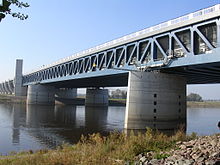

For centuries, the Elbe has been an important north-west-south-east connection in the region for inland shipping , as it connects Magdeburg with the seaports of Hamburg and Dresden . The importance of the Elbe for freight transport has decreased significantly, from around 2 million tons in 1998 to 0.3 million tons in 2016.
The greater areas of Berlin , Hanover , Halle (Saale) / Leipzig and the Ruhr area are connected by the Mittelland Canal north of Magdeburg, which crosses the Elbe in a trough bridge before it meets the Elbe-Havel Canal east of the waterway junction. The Rothensee Sparschleuse is part of the waterway crossing ; it enables large motor cargo ships and push convoys up to 185 meters in length to call at Magdeburg harbor from the Mittelland Canal or to switch to the Elbe. The lock replaced the Rothensee ship lift from 1938 in 2006. However, this historic structure was put back into operation in 2013 after being closed for seven years and is now used for pleasure craft and tourist boats. An initiative protested against the closure of the technical monument. The Niegripp lock to the east , which is responsible for the Elbe-Elbe-Havel canal connection, and the Hohenwarthe lock , which compensates for the height difference between the two canals, also belong to the completion of the waterway cross . The waterway cross should lead to a significant increase in the amount of goods transported on the Elbe and on the Mittelland Canal. These forecasts have not been confirmed.
The port of Magdeburg is the largest inland port in the new federal states and consists of four individual ports: canal port , industrial port , Hanseatic port and commercial port . Its location makes it a good starting point for cargo handling. Goods of all kinds can be handled at the ports, including grain, sugar, metals and petroleum products. In 2010, three million tons of goods were handled. The entire port is 655 hectares. The low water lock was opened in December 2013 . This means that the Hanseatic Port and the Canal Port are navigable all year round, regardless of the water level of the Elbe.
In 2018, the port operator Magdeburger Hafen GmbH handled around 2.4 million tonnes (2014: 3.5 million t, 2015: 4.1 million) of goods. The turnover was 10.5 million euros.
In terms of tourism, Magdeburg is opened up on the water by the White Fleet with its main pier at the Petriförder. Among other things, it offers tours on the Elbe and to the waterway cross. River cruise ships also call at Magdeburg regularly. There are several marinas in the recreational shipping sector.
Under the direction of Magdeburg, the European cities of Aarhus , Białystok , Manresa , Halle (Saale) , Newcastle upon Tyne , Piraeus and Vienna have come together to form the “REDIS” project (Restructuring Districts into Science Quarters). The aim is to convert a city district into science quarters. They are funded by the European Union through the “URBACT” program. Magdeburg wants to convert the commercial port into a museum and science port in the future . In 2007, in a first step, two old granaries south of the port were converted into offices for innovative companies and research institutions. In 2006 the “Virtual Development and Training Center” of the Fraunhofer Institute for Factory Operation and Automation (IFF) was established at the old trading port .
Air traffic
Magdeburg Airfield , built in 1936, is located on the southern outskirts . It can be reached via public transport (tram and bus) or via the A 14. The airfield is currently leased to the private FMB Flugplatz Magdeburg Betriebsgesellschaft mbH and is used for air sports (glider pilots, parachutists), private pilots and for sightseeing flights (balloon rides). It recorded around 30,000 aircraft movements on two runways per year (in 2012: 31,722), around 12,000 of which are powered flights.
Magdeburg-Cochstedt Airport, built in 1956, is 40 kilometers south-southwest of Magdeburg and will be temporarily closed from September 1, 2016 after the operating permit has been suspended.
The nearest major commercial airports are Leipzig / Halle , Berlin-Tegel , Berlin-Schönefeld and Hanover airports . Leipzig / Halle Airport can be reached directly from Magdeburg without changing via InterCity connection.
media

The State Broadcasting House of Saxony-Anhalt of the Central German Broadcasting Corporation (MDR) with its television and radio studios is located in Magdeburg . Regional television stations from Magdeburg are MDF.1 , the Open Channel and culture MD . There are also some internet-based broadcasters, including “Kulturmd InternetTV”, “CampusTV” from the University of Magdeburg and “MD-Web TV”, which, in addition to cultural contributions, mainly produces sports programs.
The only public radio station in Magdeburg is MDR Sachsen-Anhalt . With its focus on information from Saxony-Anhalt, it is the second most popular radio station in Saxony-Anhalt. The music genre is mainly hit and oldies . There are also two private radio programs that are produced in the “Hansapark”: radio SAW and Rockland Sachsen-Anhalt . Radio SAW is the first private radio station in Saxony-Anhalt, the private radio station with the widest coverage in the east and at the same time it has the most listeners in Saxony-Anhalt with over 258,000 listeners per hour. Viewed across Germany, it ranks fourth among the ten most popular radio stations. The target group are 10 to 49 year olds. Rockland Sachsen-Anhalt also aims at a young audience and mainly plays rock music as well as services accompanying the program. It was the first digital radio station in Germany. The university also operates the radio station GUERICKE FM .
The oldest German-language newspaper, the Magdeburgische Zeitung , appeared in Magdeburg without interruption from 1664 to 1944 . Then it was merged with the Nazi newspaper "Der Mitteldeutsche - Neues Magdeburger Tageblatt". The only local daily newspaper is the Magdeburger Volksstimme (circulation approx. 190,000). It is printed by Magdeburger Verlags- und Druckhaus GmbH . The Bild newspaper is represented by a local editorial office. "Magdeburger Sonntag" (circulation: approx. 130,000) and "elbekurier" (circulation: approx. 110,000) have been appearing as a weekly advertising paper since 1992. In addition, the “ General-Anzeiger ” has been published twice a week since 1990 (circulation: approx. 600,000).
Since 1993 the national business magazine “Wirtschaftsspiegel” has been published in Magdeburg. In addition, the Magdeburg Chamber of Crafts, together with the Chamber of Crafts in Lower Saxony, publishes the business newspaper Norddeutsches Handwerk (circulation: approx. 95,000). A special feature is the weekly Catholic newspaper Tag des Herr , published by the Archdiocese of Berlin and the dioceses in Dresden-Meißen , Erfurt , Görlitz and Magdeburg .
The city magazines " DATEs " (circulation: approx. 28,000), "port01 Magdeburg" (circulation 10,000), "Kulturschwärmer" (circulation 13,000) and "Urbanite" (circulation approx. 30,000) appear monthly. The "Magdeburger Kurier" with the subtitle "for citizens in active retirement" appeared as a monthly magazine from 1994 to April 2017 and has been published as a purely online edition since May 2017. The newspaper "Magdeburg Kompakt" (founded in 2012; circulation 25,000, as of 2017) has been published twice a month since 2014 and deals with special topics around and from Magdeburg. Since 2006 the leisure planner “where” has been published in Magdeburg with two issues for the whole of Saxony-Anhalt.
Public facilities

Magdeburg is now an important administrative center for various facilities, institutions, corporations and institutions under public law .
After the reunification of Germany, Magdeburg was elected the state capital of Saxony-Anhalt. It is therefore the seat of the state parliament of Saxony-Anhalt as well as the state government of Saxony-Anhalt and the state ministries . These include the State Chancellery and Ministry of Culture , the Ministry of Interior and Sport , the Ministry of Justice and Equality , the Ministry of Finance , the Ministry of Education , the Ministry of Economy, Science and Digitization , the Ministry of Labor, Social Affairs and Integration , the Ministry of Environment, Agriculture and Energy and the Ministry of State Development and Transport .
The Magdeburg Justice Center Eike von Repgow on Breiten Weg is the seat of various courts. Among these are in addition to the District Court of Magdeburg , the Labor Court Magdeburg , the Social Court Magdeburg , the Administrative Court of Magdeburg and the Higher Administrative Court of Magdeburg . In its own building on Halberstädter Strasse, there is also the Magdeburg Regional Court , where in January 2011 the nationwide trial of the appeal proceedings in the case of Oury Jalloh's death was negotiated.
The General Directorate for Waterways and Shipping has a location in Magdeburg (formerly Waterways and Shipping Directorate East ). The Magdeburg Waterways and Shipping Office with a building on Fürstenwall is responsible for maintaining the federal waterways and operating the facilities. The Magdeburg Waterways Construction Office (WNA Magdeburg) is responsible for the construction projects in Project 17 of the German Unity Transport Projects (waterways). In addition, the International Commission for the Protection of the Elbe (IKSE) has its seat in Magdeburg.
The Federal Network Agency has a branch in Magdeburg responsible for location certificates for EMF / EMVU .
The Magdeburg-based diocese of Magdeburg belongs to the Roman Catholic Church of Christianity . It emerged from the ore monastery of Magdeburg and has various deaneries and church institutions in Saxony-Anhalt. It also maintains a partnership with the Kaišiadorys diocese in Lithuania . The sacred institution with the largest number of members in Magdeburg is the Evangelical Church in Central Germany (EKM). It is one of 20 member churches of the Evangelical Church in Germany (EKD). Magdeburg is the seat of the regional bishop.
The Oberfinanzdirektion Magdeburg, subordinate to the Ministry of Finance Saxony-Anhalt, is located in Otto-von-Guericke-Straße and stands out due to its special architecture. The Telemann-Gesellschaft eV (International Association) was founded in Magdeburg in 1991 and has its headquarters here. Other institutions in Magdeburg are the Federal Examination Office, which is one of nine examination offices in Germany, the State Office for Consumer Protection - Hygiene Department, the Federal Institute for Real estate tasks Magdeburg, Magdeburg Employment Agency and the Magdeburg branch of the Deutsche Bundesbank (only branch in Saxony-Anhalt), which is subordinate to the main administration in Bremen, Lower Saxony and Saxony-Anhalt in Hanover, the main customs office , the Magdeburg Federal Police Inspection , which is subordinate to the Pirna Federal Police Directorate is, the district military replacement office and the Magdeburg branch of the Federal Agency for Technical Relief (THW).
Education and Research
Colleges
Magdeburg is home to the Otto-von-Guericke University , which from 1953 was founded in 1993 and later in Technical University and Technical University of Magdeburg renamed College of Schwermaschinenbau Magdeburg and from the established 1954 Medical Academy Magdeburg and from the Pedagogical University Magdeburg emerged. This makes the university one of the youngest universities in Germany. The lines of tradition of the three universities are still recognizable in the focus areas of today's modern university, because their profile still includes engineering and natural sciences as well as medicine and economics, social sciences and humanities. Research focuses on the neurosciences , dynamic systems and automotive .
Because of its location in the center of Germany and its history, Otto von Guericke University sees itself as the bridge between Western and Eastern Europe, which is also evident from the internationalization of research and teaching. The inventor, natural scientist and mayor of the city Otto von Guericke was chosen as the namesake, as he became famous around the world for his pioneering research on vacuum and air pressure . He is considered the founder of vacuum technology and also the inventor of the barometer and the air pump . Almost 14,000 students study at the university in a total of nine faculties with over 70 courses.
The university's central facilities include the university library with a holdings of around 1.2 million volumes, the university's language center, which offers student courses in foreign languages, and the technology transfer center, which is a central communication and service point for the university and represents economy. Other facilities are the audio-visual media center, the university archive, the sports center, the university computer center, the central service facilities of the medical faculty, the patent information center, the DIN display point and the international meeting center.
There is also a location for the Magdeburg-Stendal University of Applied Sciences in the city. It was founded in 1991 and continues the hundred-year tradition of engineering training, because in 1793 there was already an art school in Magdeburg for drawing training for construction professionals. It was later renamed the “Magdeburg Provincial, Arts and Crafts School” and then “Engineering School for Construction”. In the 1950s, a college for chemistry was relocated to Magdeburg (area of water management ). This and the engineering school for mechanical engineering and electrical engineering shaped the city very much. All departments can be found on a new campus between Elbauenpark and Herrenkrug. 4800 students are currently enrolled at the Magdeburg University of Applied Sciences. The University of Applied Sciences in Magdeburg has five departments and offers more than 30 degree courses, some of which are rare or unique in Germany. The head of the university is Anne Lequy.
Other scientific institutions and institutes
Magdeburg is home to a large number of research institutions and has thus established itself as a successful science location.
Founded in 1991, the departments of the Fraunhofer Institute for Factory Operation and Automation (IFF) focus on research and development in the fields of engineering and economics in the areas of industrial engineering and business informatics . The Max Planck Institute for Dynamics of Complex Technical Systems , founded in 1996, is the first institute of the Max Planck Society to focus on engineering. The Leibniz Association has maintained the Leibniz Institute for Neurobiology (LIN) in Magdeburg since 1992 , which deals with natural sciences in the field of neurosciences and molecular biology . Europe's first 7 Tesla ultra-high field magnetic resonance tomograph has been located there since 2005. There is also the Helmholtz Center for Environmental Research - UFZ (Water Research Section) with one of six locations and the German Center for Neurodegenerative Diseases - DZNE , which examines the possibilities of learning to improve memory, with one of nine locations in Magdeburg. The state capital Magdeburg continues to be a "corporative supporting member" of the Max Planck Society .
Otto von Guericke University Magdeburg also maintains the Center for Neuroscientific Innovation and Technology (ZENIT) and the Center for Qualitative Education , Counseling and Social Research (ZBBS).
Several research institutions have settled in Magdeburg's science port , the former commercial port of the city. An example is the ifak - Institute for Automation and Communication , founded in 1991 , which deals with the process industry , environmental technology and sensor and measurement technology , among other things . Other facilities in the Science Port are the Experimental Factory , a research and transfer center for application-oriented research , the Virtual Development and Training Center (VDTC) of the Fraunhofer Institute for Factory Operation and Automation (IFF), a modern research center for virtual technologies with high-tech laboratories , and the Elbe Office, completed in 2009, as an office and research building with modern technology and equipment.
The Gender Institute Saxony-Anhalt (GISA) works on the bundling, realization and coordination of research and educational activities for the implementation of the gender mainstreaming concept. With the mechanisms of cognitive brain functions , such as The Institute for Cognitive Neurology and Dementia Research (IkND) deals with issues such as memory, motivation, action, decision-making and traffic control . The institute's focus is on research into disorders of brain functions and neurodegenerative diseases . Other institutes are the Institute of the Fire Brigade Saxony-Anhalt (IdF LSA) and the Institute for Coatings and Paints (ILF).
In addition, the following science-promoting institutions and organizations are located in Magdeburg:
- Research and Development Center Magdeburg (FEZ)
- Business start-up and technology transfer center
- InnoMed - product development in the field of medical technology and health services
- Innovation and start-up center for renewable raw materials (IGZ)
- Rationalization Board of German Business
- Technology and Vocational Training Center Magdeburg (tbz)
- Technology transfer and innovation promotion Magdeburg (tti)
- Center for Product, Process and Process Innovation GmbH (ZPVP)
- Center for Telemann care and research
Projects and events
In addition to the universities, various research projects are also taking place in Magdeburg at non-university scientific institutions. In order to strengthen the city as a science and research location , it became a project partner of the URBACT project EUniverCities . The aim of this project is to strengthen the cooperation between city administrations and universities at the local level. The project's negotiation topics are, for example, the development of effective marketing strategies, the promotion of technology transfer and the expansion of relationships in business and science. Likewise, the needs of a student cultural scene and special housing offers or local transport solutions are addressed. Other partners in the EUniverCities project are Aachen , Aveiro , Delft , Gent , Lecce , Linköping , Lublin , Tampere and Varna .
A project of the city of Magdeburg is the conversion of the historic trading port near the university into a modern science port . As a diverse urban quarter with residential use, services, leisure and tourism, a center for science and research is to be created there. The flagship building in the Science Harbor is the think tank, which combines two former grain stores and was converted into 4600 m² office space for innovative research companies.
In addition, the OVGU is working with other partners in Saxony-Anhalt in applied logistics and transport research on the reference project "Transport Galileo" with the targeted development of innovations in the transport, mobility and logistics sector. The European satellite navigation system as well as other satellite and terrestrial positioning, navigation and communication systems are used for the implementation . The infrastructure of the Galileo test field extends not only to Magdeburg but also to Halle (Saale).
2006 was the year of science in Magdeburg . This was an initiative of the city administration in cooperation with research facilities and other institutions from all areas of society in the city. Over 200 events took place throughout the year, including major events such as the kick-off event in Magdeburg's Johanniskirche , the RoboCup Junior World Cup qualification tournament, the Science Festival in the new Science Harbor and the European Congress of Science Cities. In addition, annual popular science events such as The Long Night of Science , which was held for the first time in the 2006 Science Year, have established themselves. Among other things, scientific lectures and fascinating experiments will take place at various locations in the city, which can be reached with a shuttle bus. Every year the event takes place under a different motto.
Another important series of events is the RoboCup German Open , which has been taking place in Magdeburg since 2010 . Several thousand visitors flock to the Magdeburg exhibition halls for each event to see robots from international teams compete against each other in various disciplines such as robot soccer , dancing and rescue.

Libraries and Archives
The public city library of Magdeburg maintains the central library, the district libraries in Magdeburg Sudenburg , Magdeburg Reform and in the Florapark and the mobile library, which has been serving the remaining districts and suburbs for more than 30 years, and has a total of around 370,000 inventory units. With the Magdeburg administrative library, a special scientific library, the university library, which is divided into the university library on the campus at Universitätsplatz and the central medical library on the campus of the medical faculty and has a stock of around 1,250,000 volumes, and the university library of the Magdeburg University of Applied Sciences -Stendal covers Magdeburg's literature needs in the field of scientific education and research. The library and archive of the Center for Telemann Care and Research have a stock of around 10,000 volumes and deal with Georg Philipp Telemann's and the music history of Magdeburg.
The Salbker bookmark in the Salbke district of Magdeburg represents a public bookcase , an event stage and a noise protection wall. The concept is that books can be taken out of the showcases and read, later put back by the users or replaced with new books. The “ Leonardo Library ”, a reference library for vocational literature, is also located in the Salbke district .
The State Archive of Saxony-Anhalt , the ministerial archive of the State of Saxony-Anhalt and the archive of the former central authorities of the Prussian Province of Saxony , the Free State of Anhalt and their predecessor territories, is a large German state archive and has around 50 running kilometers of storage media from eleven centuries of German history at five locations .
Other noteworthy archives are the State Church Archives Magdeburg and the Stasi Archives Magdeburg, with a total of around 7,000 linear meters of documents, topographical maps as well as image and audio documents of the former Magdeburg State Security . The diocese of Magdeburg maintains its own library with around 2500 volumes and its own archive. Holdings of the Magdeburg City Archives can be accessed online in Archivportal-D .
School system
The school landscape in Magdeburg is diverse. A total of 37 primary schools , including z. B. the "Trilingual International Primary School", the "St. Mechthild Primary School", 13 secondary schools , including the sports secondary school "Hans Schellheimer" or the "Evening Secondary School", eight grammar schools , for example the " Werner-von-Siemens grammar school " with a mathematical and natural science focus and the " Sportgymnasium Magdeburg ", there are also two integrated comprehensive schools and a total of four vocational schools in Magdeburg.
There are also ten special schools , an eco school (school environment center), a botany school, an adult education center , a painting school and some music schools, including the Georg Philipp Telemann Conservatory with around 2,600 students.
Healthcare
The city is a member of the nationwide Healthy Cities Network (GSM) and has a good medical infrastructure with two maximum care providers, two additional hospitals and a large number of resident doctors. There are around 480 inhabitants for one doctor. The maximum care providers include the Magdeburg University Hospital with 1128 beds and the Magdeburg Hospital with over 735 beds. The Pfeiffer Foundations with 234 beds and the St. Marienstift Hospital with 125 beds provide basic care . In addition, the Pfeiffer Foundations opened Saxony-Anhalt's first children's hospice in March 2013, and at the same time the first Protestant children's hospice in the new federal states . Terminally terminally ill children are cared for there as part of palliative medicine and care , with family support being a key element. The Klinik des Westens Magdeburg is a ten-bed clinic. The Praxisklinik Sudenburg is a medical center with four operating theaters. The Median Kliniken operate the Neurological Rehabilitation Center Magdeburg. The day clinic at the Sternbrücke, Dr. Kielstein GmbH , treats addiction disorders and psychosomatic disorders, the specialist clinic Alte Ölmühle treats addiction disorders .
Garrison Magdeburg
In the past, Magdeburg was a large and important garrison of the Prussian army , the Reichswehr , the Wehrmacht and, after 1945, the Soviet army with a variety of military facilities such as barracks , hospitals , depots , etc.
An artillery barracks (Am Charlottentor / Turmschanzenstrasse, demolished after 1945), a pioneer barracks (later Mudrakaserne ) on Turmschanzenstrasse, an artillery barracks (later Beseler barracks ) on Brückstrasse, the Angerkaserne (later von Seeckt barracks ) came from the Prussian era. on Jerichower Straße / Herrenkrug, the Enckekaserne and the Sixt-von-Arnim-Kaserne , Am Zuckerbusch.
During the armament of the Wehrmacht , the Hindenburg barracks (adjacent to the Angerkaserne), the Adolf Hitler barracks and a new on-site hospital , the Luitpold barracks and the General von Hippel barracks (the latter three on the north side ) were rebuilt in the 1930s today Breitscheidstraße) in Prester barracks of anti-aircraft artillery and in Friedenweiler an air base of the Air Force .
After 1945, almost exclusively Soviet troops were housed in Magdeburg (the headquarters of the 3rd Shock Army or, from 1954, 3rd General Army with subordinate parts). The NVA was only weakly represented with a few smaller agencies. In the early 1990s, the Soviet troops withdrew on the basis of the two-plus-four treaty . Today Magdeburg is the seat of the state command Saxony-Anhalt of the Bundeswehr .
Personalities
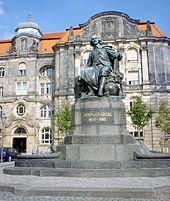
Honorary citizen
The Lord Mayor grants honorary citizenship , the highest distinction in the city of Magdeburg , to people who have rendered outstanding services to the city . It has been awarded since the 19th century. So far, 46 honorary citizenship titles have been awarded in Magdeburg. Among them are, for example, Otto von Bismarck (Reich Chancellor), Carl Gustav Friedrich Hasselbach (Lord Mayor 1851–1880) and the so far only woman Angela Davis (peace fighter in the USA).
sons and daughters of the town
Born Magdeburg of importance include Hermann Gruson , an inventor, scientist and industrial entrepreneur , Adelbert Delbrück , the founder of Deutsche Bank, Ludwig Karl Friedrich Detroit (Mehmed Ali Pascha), Pascha in the Ottoman Empire, Friedrich Wilhelm von Steuben , Prussian officer and US -american general, Georg Philipp Telemann , an important composer of the Baroque era , Georg Kaiser , the most successful playwright of the expressionist generation and Otto von Guericke , the founder of vacuum technology and mayor of Magdeburg, as well as Major General Henning von Tresckow , a resistance fighter against National Socialism.
City personalities
The work of Emperor Otto I of the Holy Roman Empire, Albert Vater , co-founder of the KPD in Magdeburg, Bruno Taut , architect and urban planner, Johann Gottlob Nathusius , royal merchant and industrialist, Thomas Höhle , literary scholar, Stefan Kretzschmar , was closely connected with Magdeburg . Handball player, Georg Meyer , fighter pilot in the First World War .
Magdeburg originals
The slag monkey is probably the best-known Magdeburg original. At the beginning of the 20th century he roamed the parts of Magdeburg city center near the Elbe and traded fish on the Elbe. His greasy coat with the large pockets in which he carried the fish was typical. He smelled accordingly.
On the city wall below the Magdalen Chapel , some originals from Magdeburg can be seen as a relief. In addition to the slag monkey , the fly- to- beetle maker , the monkey father , the Lusebenecke , the Blutappelsine and the Feuerkäwer are the best-known Magdeburg originals.
In art and culture
- The Magdeburg Centuries , a Protestant church history of the 16th century, are named after the initiator and chief editor, who were both Magdeburg preachers.
- Wilhelm Raabe's Magdeburg novel Unseres Herrgotts Kanzlei was published in 1862.
- Gertrud von le Fort published the novel The Magdeburg Wedding in 1938 .
- The city of Magdeburg is the linchpin of a piece of music that was created in 1992 by Manfred Maurenbrecher . This song, entitled Magdeburg 92 , was later interpreted by Diether Dehm , member of the Bundestag .
- Hurenkarrentaler , Schautaler of the city of Magdeburg for the foundation of the city
- Luftpumpentaler , first stamp with the representation of the attempt to separate the Magdeburg hemispheres as well as the first stamp ever with reference to Otto von Guericke.
- From the foundation of Magdeburg , Sage
Movies
- Picture book Germany. Around Magdeburg. Documentary, Germany, 1999, 43:30 min., Written and directed: Birgit von Gagern, production: MDR, series: Bilderbuch Deutschland , episode 153, first broadcast: September 12, 1999 on Das Erste , synopsis by fernsehserien.de . Travel report on the occasion of the Federal Garden Show 1999.
- 1631 - The Magdeburg massacre. Documentary with game scenes, Germany, 2005, 42:28 min., Script and director: Anne Roerkohl, director of the game scenes: Hannes Schuler, production: Ottonia Media, MDR, WDR , SR , arte , series: The great battles , first broadcast: 20 May 2006 at arte, summary by Anne Roerkohl and online video .
- A touch of Moscow in Magdeburg - the Stalin buildings. Documentary, Germany, 2014, 29:54 min., Script and direction: Dirk Schneider , moderation: Axel Bulthaupt , production: MDR, series: Der Osten - Discover where you live , first broadcast: April 22, 2014 on MDR, synopsis by MDR , ( Memento of February 4, 2017 in the Internet Archive ).
- Gustav Adolf II. The fight for Magdeburg. Documentary with game scenes, Germany, 2014, 43:45 min., Script and director: Judith Voelker, director of the game scenes: Pepe Pippig, production: Saxonia Entertainment, MDR, series: Geschichte Mitteldeutschlands , first broadcast: August 24, 2014 on MDR television, Synopsis of the MDR, ( memento from February 26, 2017 in the web archive archive.today ).
- Magdeburg - past, present and future. Knowledge broadcast, Germany 2014, 58 min., Moderation: Victoria Herrmann , production: MDR, series: LexiTV , first broadcast: September 2, 2014 on MDR, synopsis by MDR, ( memento from July 23, 2015 in the Internet Archive ).
- Where steel was hardened - the mechanical engineering city of Magdeburg. Documentary, Germany, 2019, 44:44 min., Script and director: Tom Kühne, production: MDR , series: Der Osten - Discover where you live , first broadcast: January 14, 2020 on MDR television , synopsis from MDR, online video available until January 6, 2021.
See also
literature
- Helmut Asmus: 1200 years of Magdeburg. From the imperial palace to the state capital. A city history in four volumes. Scriptum, Magdeburg 2000–2009.
- Helmut Asmus, Manfred Wille : 1200 years of Magdeburg. Volume 1: The years 805 to 1631. 2000. 2nd, revised edition, 2005, ISBN 978-3-933046-15-4 , table of contents .
- Helmut Asmus: 1200 years of Magdeburg. Volume 2: The years 1631 to 1848. 2002, ISBN 978-3-933046-16-1 , table of contents .
- Helmut Asmus: 1200 years of Magdeburg. Volume 3: The years 1848 to 1945. 2005, 2nd edition 2008, ISBN 978-3-00-037844-7 , table of contents .
- Helmut Asmus: 1200 years of Magdeburg. Volume 4: The years 1945 to 2005. 2009, ISBN 978-3-00-037845-4 , table of contents .
- Johann Christian Friedrich Berghauer: Magdeburg and the surrounding area. Keil, 1800, digitized in Google Books .
- Chronicle of the city of Magdeburg. Issues 1–5, 1831, digitized in Google Books .
- Georg Dehio : Handbook of the German art monuments . Saxony-Anhalt. Volume 1: Ute Bednarz, Folkhard Cremer u. a .: Administrative region of Magdeburg. Revision. Deutscher Kunstverlag, Munich a. a. 2002, ISBN 3-422-03069-7 .
- Ronald Floum, Michael Schwibbe , Ira Spieker: ZeitReise: 1200 years of life in Magdeburg. Elbe Report, Magdeburg 2005, ISBN 3-00-016464-2 .
- Nadja Gröschner: Magdeburg. Yesterday and today. A comparison. Wartberg, Gudensberg-Gleichen 2002, ISBN 3-8313-1117-X .
- Friedrich Wilhelm Hoffmann: History of the city of Magdeburg. Volumes 1–3, Magdeburg 1845–1850, digitized in Google books .
- Erich Keyser (Ed.): German city book. Handbook of urban history, Volume II, Central Germany. On behalf of the Conference of the Regional History Commissions of Germany with the support of the German Municipal Association, Stuttgart 1941.
- Manfred Köppe (Hrsg.): Magdeburg - portrait of a city. Stekovics, Halle (Saale) 2004, ISBN 3-932863-50-X .
- Babette Ludowici, Matthias Springer : Magdeburg. In: Reallexikon der Germanischen Altertumskunde (RGA). 2nd Edition. Volume 19, Walter de Gruyter, Berlin / New York 2001, ISBN 3-11-017163-5 , pp. 130-136.
- Magdeburg and its surroundings (= values of our homeland . Volume 19). 1st edition. Akademie Verlag, Berlin 1973.
- Hans-Joachim Mrusek : Magdeburg . (= Art history city books ). 2nd Edition. Leipzig 1966.
- Ernst von Niebelschütz : Magdeburg . (= German Land - German Art ). German Art Publishing House, Berlin 1929.
- Matthias Puhle (ed.): Magdeburg 1200. Medieval metropolis, Prussian fortress, state capital. The history of the city from 805 to 2005. (Exhibition by the Kulturhistorisches Museum Magdeburg , May 8 to September 4, 2005.) Theiss, Stuttgart 2005, ISBN 3-8062-1933-8 .
- Matthias Puhle, Peter Petsch, Maik Hattenhorst: Magdeburg: the history of the city 805-2005. Stekovics, Halle (Saale) 2005, ISBN 3-89923-105-8 .
- Matthias Puhle: Otto the Great: Magdeburg and Europe. Essays. 2 volumes. Philipp von Zabern, Mainz 2001, ISBN 3-8053-2616-5 .
- Manfred Zander, Malte Zander: Magdeburg. Mitteldeutscher Verlag, Halle (Saale) 2008, ISBN 978-3-89812-424-9 , (city guide).
To architecture
-
Ingelore Buchholz : Magdeburg as it was. Volume 1. (= photographed contemporary history ). Droste Verlag, Düsseldorf 1991, ISBN 978-3-7700-0958-9 .
Ingelore Buchholz: Magdeburg as it was. Volume 2. Droste Verlag, Düsseldorf 1997, ISBN 978-3-7700-1084-4 . - Olaf Gisbertz: Bruno Taut and Johannes Göderitz in Magdeburg. Gebrüder Mann, Berlin 2000, ISBN 3-7861-2318-7 .
- Eckhart W. Peters (Ed.): Magdeburg - Architecture and Urban Development. J. Stekovics, Halle an der Saale 2001, ISBN 3-929330-33-4 .
- Sabine Ulrich, Eckhart W. Peters: Wilhelminian style villas in Magdeburg. (= Expert opinion of the city planning office. Issue 51). Magdeburg 1995, PDF, 7.5 MB , (list of all Wilhelminian style villas, some of which have since been demolished, with photos and articles).
- Erich Wolfrom: The building history of the city and fortress Magdeburg. Magdeburg 1936, DNB 363111719 .
Web links
- City of Magdeburg with city map
- Michael Jäger: Magdeburg Chronicle (private website, last updated 2017)
- Magdeburg Biographical Lexicon of the University of Magdeburg (biographies on the recent regional history of Magdeburg and the surrounding area, 1998 to 2005)
- Magdeburg - topography and settlement in the urban development project in Saxony-Anhalt
- Link catalog on Magdeburg at curlie.org (formerly DMOZ )
Individual evidence
- ↑ State Statistical Office Saxony-Anhalt, population of the municipalities - as of December 31, 2019 (PDF) (update) ( help ).
- ↑ State Statistical Office Saxony-Anhalt. Total population, Germans and foreigners by district on September 30, 2018. Retrieved May 20, 2019 .
- ↑ a b Magdeburg in figures 2009/2010 . Leaflet from the Statistical Office, State Capital Magdeburg, (PDF; 1.6 MB).
- ↑ Almost eleven and a half percent of the city's area are public green spaces - Hanover is the greenest city in Germany. (No longer available online.) In: PR-inside.com. March 13, 2007, archived from the original on June 24, 2007 ; accessed on December 1, 2015 .
- ↑ Urban agglomerations (Germany): & Urban agglomerations - population figures, graphics and map. Accessed August 21, 2020 .
- ^ Magdeburg. In: German Weather Service (DWD).
- ^ Magdeburg. In: wetterkontor.de .
- ^ Magdeburg. In: onomastik.com (names and meanings of names), April 22, 2005.
- ↑ Harald Bichlmeier: Once again on the place name Magdeburg. In: Namenkundliche Informations 97, 2010 [2011], pp. 109–132
- ↑ cf. Maid in the Grimm dictionary
- ^ Fr. Hülße: Sagen der Stadt Magdeburg , Albert Rathke's Verlag, 1895, quoted in: Michael Jäger: Magdeburger Chronik - Magdeburg before the first mention. In: Magdeburg Chronicle. Retrieved December 1, 2015 .
- ↑ On the foundation and the name of the city. In: Sigillum salomonis magdeburgensis , 2010.
- ↑ Bernd Kluge : OTTO REX / OTTO IMP. On the inventory of Ottonian coinage , in: Bernd Schneidmüller , Stefan Weinfurter (Eds.): Ottonian new beginnings. Symposium on the exhibition "Otto the Great, Magdeburg and Europe" , von Zabern, Mainz am Rhein 2001, ISBN 3-8053-2701-3 , pp. 101-102.
- ^ The diocese of Brandenburg in the XV. and XVI. Century .
- ^ Franz Schrader: Christianization began a good 1200 years ago. Overview of the history and prehistory of the Diocese of Magdeburg from the early Middle Ages to the present day 777-1994. In: Diocese of Magdeburg .
- ^ Hanseatic City of Magdeburg. In: Städtebund Die Hanse .
- ^ Michael Jäger: Magdeburg Chronicle - 1600–1699. In: Magdeburg Chronicle. Retrieved November 30, 2015 .
- ↑ Großer Generalstab (Ed.): 1806 - The Prussian officer corps and the investigation of the war events . Ernst Siegfried Mittler and Son, Berlin 1906.
- ↑ Friedrich Justin Bertuch : General geographical ephemeris . tape 50 . Publishing house d. Industrie-Comptoirs, Weimar 1816, p. 361 f . ( Digitized version ).
- ^ Official Journal of the Government of Magdeburg 1861, p. 218
- ↑ Hans Christoph Buch : It's provincial everywhere. In: Die Zeit , May 28, 2014, No. 23, p. 51, review without references.
- ↑ Traces of History. May 4, 1945 - Surrender on the Timeloberg near Lüneburg , accessed on: May 16, 2018
- ↑ Sven Voss in the television knowledge magazine Echt! of the MDR on March 9, 2010.
- ^ Magdeburg. In: kirchensprengung.de .
- ↑ The town hall. In: magdeburg.de. Retrieved February 8, 2015 .
- ^ Sabine Tacke: Palais am Fürstenwall. History and present. In: Press office of the Ministry for Building and Transport of the State of Saxony-Anhalt , January 2006, (PDF; 38 p., 9.4 MB), p. 36.
- ↑ University of Passau has Germany's most beautiful campus. (No longer available online.) In: unicum.de . Archived from the original on December 10, 2010 ; Retrieved February 8, 2015 .
- ^ Summer floods in 2002 in Magdeburg. ( Memento from February 7, 2013 in the Internet Archive ) In: hochwasser.feuerwehr-magdeburg.org .
- ^ Damage event (flood in Saxony-Anhalt in June 2013). (PDF; 76 kB) (No longer available online.) In: Landesportal. State of Saxony-Anhalt - Ministry of the Interior, June 11, 2013, archived from the original on February 26, 2014 ; accessed on December 1, 2015 .
- ↑ State Statistical Office Saxony-Anhalt, population of the municipalities - as of December 31, 2019 (PDF) (update) ( help ).
- ↑ State Statistical Office of Saxony-Anhalt: Figures - Data - Facts. ( Memento from May 17, 2018 in the Internet Archive ). In: Monthly Bulletin of the Saxony-Anhalt State Statistical Office , May 2018, page 40, (PDF page 42).
- ↑ Martin Rieß: End of the Magdeburg population boom. Retrieved May 15, 2018 .
- ↑ Statistics + Geodata - State Capital Magdeburg. State capital Magdeburg, accessed on May 16, 2018 ( monthly statistical figures March 2018 ).
- ^ Regensburger Zeitung , No. 171 of July 20, 1829, p. 1 ( online )
- ↑ a b c d e f g h i j k l m n M. Rademacher: German administrative history from the unification of the empire in 1871 to the reunification in 1990. Stadtkreis Magdeburg (online material for the dissertation, Osnabrück 2006),
- ^ Meyer's Large Conversational Lexicon . 6th edition, Volume 13, Leipzig / Vienna 1908, pp. 59-62 ( Zeno.org );
- ↑ fowid church members in German big cities
- ↑ religion population selected cities
- ↑ Achim Todenhöfer: Churches of the mendicant orders. The architecture of the Dominicans and Franciscans in Saxony-Anhalt. Reimer, Berlin 2010, ISBN 978-3-496-01396-9 , pp. 100-115.
- ↑ Main statutes of the state capital Magdeburg (PDF; 1.3 MB)
- ↑ a b c New version of the main statute of the state capital Magdeburg. In: Official Journal of the State Capital Magdeburg No. 17 of July 11, 2007, (PDF; 18 p., 188 kB).
- ↑ campaign Otto city of Magdeburg.
- ↑ Birgit Ahlert: Otto-Treffen 2011. The “Biggest Otto-Meeting”: Big Otto, small Otto, very young and very old came from everywhere . In: Volksstimme , July 4, 2011.
- ↑ campaign Otto Magdeburg
- ↑ Ottostadt campaign. Conclusion of the city of Magdeburg. October 18, 2010, (PDF; 8 pp., 72 kB).
- ↑ City Brand of the Year 2013. Magdeburg Ottostadt campaign awarded. (No longer available online.) In: MDR Kultur . Mitteldeutscher Rundfunk, October 25, 2013, archived from the original on October 29, 2013 ; accessed on December 1, 2015 .
- ↑ Handover of the Cleve Bastion. In: International Building Exhibition Urban Redevelopment Saxony-Anhalt 2010 (IBA).
- ^ "Old Town Hall" - "New Town Hall" form an ensemble on Magdeburg's Old Market. In: magdeburg.de .
- ^ Jw: Three interested parties for Hypar bowl in Magdeburg city park . In: Volksstimme of November 16, 2013.
- ^ Rochus Görgen: Dreigestirn in Magdeburg. A deer represents paradise. In: Mitteldeutsche Zeitung , November 9, 2012.
- ↑ Robert von Lucius : The tsarina returns home. In: FAZ , April 17, 2009.
- ^ Bridges of Magdeburg. In: brueckenweb.de .
- ↑ Information from the City of Magdeburg on the planned extension of the power bridge. In: magdeburg.de , accessed on January 23, 2020.
- ↑ Karolin Aertel: Museum apartment in Magdeburg - the GDR lives at the bottom right. In: Volksstimme. Magdeburger Verlags- und Druckhaus GmbH, March 29, 2014, accessed on December 1, 2015 .
- ↑ We'll tell you! About us. ( Memento from February 19, 2016 in the Internet Archive ). In: Sponsoring Association - Freiluft-Atelier e. V.
- ↑ Aerosol arena: open-air studio: the colorful experiment has begun. In: Volksstimme , August 12, 2012.
- ↑ Theater: Almost 175,000 spectators in 2013 in the Magdeburg Theater. In: Focus Online . February 12, 2014, accessed February 8, 2015 .
- ↑ Ensemble guests: The ball lightning. In: Magdeburger Zwickmühle , accessed on February 27, 2017.
- ↑ Florian Schreiter: Cabaret Po-Ente - New point-rich cabaret. In: urbanite.net , March 21, 2013.
- ^ Magdeburg in Figures 2015 - Tourism. In: Office for Statistics Magdeburg , (PDF; 1.5 MB).
- ↑ chap. 26.2.3 The top 50 in city tourism in 2015. Arrivals and overnight stays from 100,000 inhabitants. In: Federal Statistical Office , Statistical Yearbook 2016, (PDF; 826 kB).
- ^ Alexander Schmolke: Hotel market. Magdeburg is growing. In: AGHZ , July 5, 2013, on the number of overnight stays in Magdeburg.
- ↑ Statistical report: Tourism - guests and overnight stays in tourist traffic, accommodation capacity. ( Memento of December 8, 2015 in the Internet Archive ). In: Statistisches Landesamt Sachsen-Anhalt , June 2015, pp. 12–13, (PDF; 822 kB).
- ↑ Traffic report 2014 of the WSD Ost. ( Memento from September 16, 2016 in the Internet Archive ). (PDF; 2 MB)
- ↑ a b Dominik Bath: Landtag. Dispute about the Elbe as an economic factor. In: Volksstimme , May 5, 2017, accessed on May 9, 2017.
- ^ Danger prevention ordinance of the state capital Magdeburg , § 8, bathing in waters. In: magdeburg.de , July 6, 2012, (PDF; 506 kB).
- ↑ The Magdeburg Adventure Park. In: bagger-erlebnis.de .
- ↑ (ag): Balance sheet 2016. Magdeburg Zoo accepts 37 new animal species. In: Volksstimme , March 27, 2017.
- ↑ Best leisure attraction in Saxony-Anhalt. In: mvgm.de , see: “ Freizeitatlas Deutschland ” in: stern , 2013, no. 27, (interactive).
- ↑ Marco Papritz: Last large-capacity disco gives up. In: Volksstimme , July 22, 2016.
- ^ Michaela Schröder: Fun pool. Sweating is back in the Nemo. In: Volksstimme , December 17, 2016.
- ↑ Marco Papritz: Conversion planned. Last night of the Magdeburg Fichte dance. In: Volksstimme , January 23, 2017.
- ↑ Sport Event Steinforth - East Germany's only professional boxing stable.
- ↑ Hans-Arthur Marsiske: RoboCup German Open: A tournament will change the venue. In: heise online , December 17, 2009.
- ↑ Stefan Harter: 4th bicycle day of action. The biking mass conquers the ring. In: Volksstimme , June 30, 2014.
- ↑ dpa / sa: Over 35,000 visitors at the 20th State Harvest Festival in Magdeburg. Regional. In: Die Welt / N24 . September 21, 2014, accessed February 27, 2017 .
- ↑ Spring and Autumn Fair Magdeburg. In: Ottopix , accessed on October 15, 2019: "Germany's oldest folk festival ... The trade fair tradition goes back to September 1010 ..."
- ↑ Peter Ließmann: 50,000 scented postcards are intended to lure visitors under the Christmas tree at the town hall. In: Volksstimme. November 17, 2011, accessed February 8, 2015 .
- ^ State capital Magdeburg: Citizens + City - State capital Magdeburg. Retrieved October 3, 2017 .
- ↑ Current results. In: Working group “National Accounts of the Federal States” (VGR dL), accessed on January 7, 2019.
- ↑ State of Saxony-Anhalt. In: Federal Employment Agency . Retrieved January 7, 2019 .
- ↑ Zukunftsatlas 2016. (No longer available online.) Archived from the original ; accessed on March 23, 2018 .
- ↑ Mechanical engineering in Magdeburg (PDF; 3 MB)
- ↑ For the section cf. Günther Korbel: The Napoleonic foundations of Magdeburg . Volume 3: On the history of building in the Sudenburg . Magdeburg 1995, (series of publications Landeshauptstadt Magdeburg, Volume 18.3), DNB 949262218 , pp. 124–128 with notes.
- ↑ Kosher schnapps from Magdeburg . In: Der Spiegel . No. 46 , 1992 ( online ).
- ↑ dpa / sa: Commodity trader Glencore wants to take over Prokon vegetable oil. In: Die Welt , December 19, 2014.
- ↑ About us. In: Glencore Magdeburg GmbH , information on the processing quantity, accessed on February 27, 2017.
- ↑ Telekom - T-Systems confirms massive job cuts. MDR Saxony-Anhalt - Magdeburg region. (No longer available online.) In: Mitteldeutscher Rundfunk. March 19, 2014, archived from the original on February 6, 2015 ; accessed on December 1, 2015 .
- ↑ The 100 largest companies in Saxony-Anhalt. In: Nord / LB , December 2013, (PDF; 16 pp., 368 kB).
- ↑ Special evaluation of the traffic survey, Mobility in Cities - SrV 2008 '. City comparison. In: TU Dresden , November 2009, (PDF; 48 p., 3.3 MB).
- ^ Railway project: Magdeburg railway junction is making progress. In: Mitteldeutsche Zeitung . June 25, 2011, accessed February 8, 2015 .
- ↑ Martin Rieß: Deutsche Bahn - 2016 track builders move to Magdeburg's main train station. In: Volksstimme. Magdeburger Verlags- und Druckhaus GmbH, February 7, 2014, accessed on December 1, 2015 .
- ↑ DB discontinues "Kaiser-Otto-Express". In: Drehscheibe Online , 2012, accessed on February 27, 2017.
- ↑ Traffic conception downtown 1997. In: City Planning Office Magdeburg , (PDF; 32 pp., 7 MB).
- ↑ Stephan Bublitz: The court also decides on the appropriateness of the costs / action planned beforehand. In: Citizens' Initiative Liveable Downtown. April 22, 2013, accessed December 1, 2015 .
- ^ Controversy and quarrel about a construction project - Chronicle of tunnel construction in Magdeburg. ( Memento from November 23, 2015 in the Internet Archive ). In: MDR Saxony-Anhalt - Magdeburg region , November 20, 2015.
- ^ Robert Richter: Vote in the Magdeburg City Council - Now the construction of the pylon bridge has been decided. In: Volksstimme. September 9, 2013, accessed December 1, 2015 .
- ↑ Anja Guse: Sternbrücke opened for cars. In: Volksstimme. November 12, 2013, accessed February 8, 2015 .
- ↑ Magdeburg Statistics, monthly report, January 2011. In: magdeburg.de (PDF; 44 pp., 4.5 MB)
- ↑ Public transport performance data. In: MVB .
- ^ Preparation of the transport association: marego - Magdeburg regional transport association. In: Magdeburger Verkehrsbetriebe , December 19, 2008.
- ^ The ADFC bicycle travel analysis 2016. ( Memento from March 1, 2017 in the Internet Archive ). In: ADFC , 2016: "The most popular long-distance cycle route in Germany is the Elberadweg for the twelfth time in a row ."
- ↑ On the bike in Magdeburg. In: Tourist-Information Magdeburg , accessed on February 27, 2017.
- ↑ a b Statement by the administration of the state capital Magdeburg on the revision of the list of priorities for pedestrian and cycle path renovation 2017ff from February 21, 2017; Opinion no S0040/17
- ↑ Transport Development Plan Magdeburg 2030 plus; Building block 1; Status analysis (status with editorial changes). (PDF; 7.8 MB) In: Tourist-Information Magdeburg. February 3, 2014, accessed February 28, 2017 .
- ↑ Answer to question F0100 / 14 in the minutes of the city council meeting of May 22, 2014 (point 7.4, p. 42; minutes of June 2, 2014), available in the citizen information portal .
- ↑ Katja Tessnow: Bicycle stand in Magdeburg is now mandatory. In: Volksstimme , June 19, 2018.
- ↑ Gerd-Axel Ahrens : Special evaluation of the traffic survey, mobility in cities - SrV 2008. City comparison. In: TU Dresden , November 2009; Table 9a, (PDF; 3.3 MB).
- ↑ Special evaluation of the research project "Mobility in Cities - SrV 2013" city comparison; Dresden, May 2015; Table 11b online under SrV 2013 city comparison.
- ↑ Special evaluation of the research project "Mobility in Cities - SrV 2013" SrV city group: regional centers up to less than 500,000 inhabitants, topography: flat Dresden, in April 2015 (updated version from May 21, 2015); Table 5.3; Available online at SrV 2013 City group regional centers under 500 TEW (PDF).
- ↑ a b Jana Wiehe: ADFC bicycle climate - Magdeburg is not sitting securely in the saddle. In: Volksstimme. Magdeburger Verlags- und Druckhaus, March 23, 2015, accessed on December 1, 2015 .
- ↑ ADFC bicycle climate test 2014 results table. ( Memento from February 20, 2015 in the Internet Archive ). In: ADFC , (PDF; 13 p., 881 kB), accessed on February 28, 2017.
- ↑ ADFC bicycle climate test 2014: detailed evaluation for Magdeburg. In: ADFC , updated on March 2, 2015, (PDF; 5 p., 294 kB), accessed on February 28, 2017.
- ↑ Christoph Deike: Bicycle theft - politics has to do homework. ( Memento of March 24, 2016 in the Internet Archive ). In: ADFC Sachsen-Anhalt eV , June 27, 2014.
- ↑ Wolfgang Beier: Bicycle roads - new paths with rarity value. In: Volksstimme. Magdeburger Verlags- und Druckhaus, August 16, 2014, accessed on December 1, 2015 .
- ↑ Wolfgang Wähnelt: Election test stones for the city council elections - cycling in Magdeburg. In: Bündnis 90 / Die Grünen , Magdeburg district association, April 26, 2014.
- ^ Election test stones of the ADFC for the 2014 local elections ( Memento from September 11, 2014 in the Internet Archive ). In: adfc-magdeburg.de , 2014.
- ↑ Conrad Engelhardt: Gladly perfect. In: DATEs Stadtmagazin , March 28, 2014, issue 4, p. 11: "Correspondence with the city lasted a year, in the end the administration rejected the advantageous measure due to" liability concerns "."
- ↑ Felix Ehrenfried: Bicycle theft statistics: Most bicycles are stolen in these cities. In: WirtschaftsWoche . June 26, 2014, accessed February 28, 2017 .
- ↑ dpa : 26,000 bicycles stolen: Berlin was a lonely leader when it came to stealing bicycles, lousy when it came to robber hunting. In: Berliner Kurier . July 17, 2014, accessed February 27, 2017 .
- ↑ Answer to the inquiry about bicycle stands on Schleinufer: MD-Melder - State Capital Magdeburg. In: magdeburg.de. September 5, 2014, accessed February 8, 2015 .
- ↑ Katharina Buchholz: Theft protection. Police discontinue bicycle coding. In: Volksstimme , June 4, 2015: "The reason for the stop of the Magdeburg coding is the absence of workers from the Society for Training, Qualification and Employment (AQB)."
- ^ Magdeburg, the city of bicycles. Now! / FahrRad-Aktionstag 2017. In: Openpetition.de , accessed on June 20, 2018.
- ^ Magdeburg City Council. Opinions. In: Openpetition.de , accessed on June 20, 2018.
- ↑ Taking bicycles with you. Stay flexible with us! In: Magdeburger Verkehrsbetriebe .
- ↑ Can I take my bike with me all day? ( Memento from September 3, 2014 in the Internet Archive ) In: marego-verbund.de , see last question.
- ^ Rail & Bike in Saxony-Anhalt. In: bahn.de
- ^ Franziska Ellrich: Feasibility Study. Magdeburg bicycle parking garage not before 2021. In: Volksstimme , June 16, 2018.
- ↑ Magdeburg Waterways Construction Office: Magdeburg waterway intersection. Magdeburg, September 1999, p. 3
- ↑ Traffic report 2010 of the WSD Ost. ( Memento of February 2, 2014 in the Internet Archive ) In: Federal Waterways and Shipping Administration , 2011, (PDF; 2.3 MB).
- ↑ Recommissioning of the Rothensee ship lift. In: magdeburg.de
- ↑ Technical monument. Rothensee ship lift celebrates reopening. ( Memento from August 26, 2013 in the Internet Archive ). In: mdr.de , August 24, 2013.
- ^ Karl-Heinz Kaiser: Head of the Magdeburg office: Shipping on the Elbe and the Canal "is in good shape". In: Volksstimme / saaleverein.de. June 3, 2014, accessed on February 28, 2017 (Interview with Friedrich Koop, Head of the Magdeburg Water and Shipping Office).
- ^ Magdeburg harbor. Low water lock goes into operation. ( Memento from January 18, 2014 in the Internet Archive ) In: mdr.de , December 12, 2013.
- ↑ Traffic report 2018 (PDF; 19.4 MB) Federal Waterways and Shipping Administration, January 2020, accessed on August 4, 2020 .
- ^ Handling in Magdeburg is increasing . In: Daily port report of January 30, 2015, p. 4.
- ^ Magdeburger Hafen: More handling . In: Daily port report of March 3, 2016, p. 4
- ↑ http://www.weisseflotte-magdeburg.de/index.php
- ↑ Robert Richter: City miscalculates when flying in flight ... In: Magdeburger Volksstimme , December 18, 2013
- ↑ Radio SAW remains the most popular station. ( Memento of March 7, 2014 in the Internet Archive ). In: Mitteldeutsche Zeitung , March 5, 2015.
- ↑ Radio SAW listener statistics. In: Newsletter of SAR Sachsen-Anhalt Radio Marketing GmbH , 2013, (PDF; 8 p., 4.1 MB).
- ↑ To our readers! In: Magdeburgische Zeitung , No. 204, August 31, 1944, p. 1.
- ^ Fritz Faber: The Magdeburgische Zeitung . In: H.-D. Fischer (Hrsg.): German newspapers from the 17th to the 20th century . Verlag Documentation, Pullach 1972, DNB 1045464228 , p. 71.
- ↑ Headquarters and branches of the Deutsche Bundesbank. In: Deutsche Bundesbank . Retrieved February 28, 2017 .
- ↑ see list of corporative sponsoring members of the Max Planck Society. ( Memento of January 14, 2011 in the Internet Archive ). In: mpg.de , (PDF; 445 kB).
- ^ Research institutions in Magdeburg. In: Research portal Saxony-Anhalt .
- ^ Magdeburg as a science location. In: magdeburg.de
- ↑ Practice-oriented science and research capacities. ( Memento from March 1, 2017 in the Internet Archive ). In: Regional Planning Association Magdeburg , accessed on February 28, 2017.
- ^ Year of Science 2006 in Magdeburg. In: University of Magdeburg .
- ↑ Archivportal-D. In: archivportal-d.de. Retrieved July 27, 2016 .
- ^ List: Our members. In: Healthy-staedte-netzwerk.de , accessed on January 23, 2020.
- ↑ Martin Rieß: First children's hospice in Saxony-Anhalt opened. In: Volksstimme. March 6, 2013, accessed February 27, 2017 .





